A summary of the lexicon and sentence structure
胡壮麟《语言学教程》分章试题
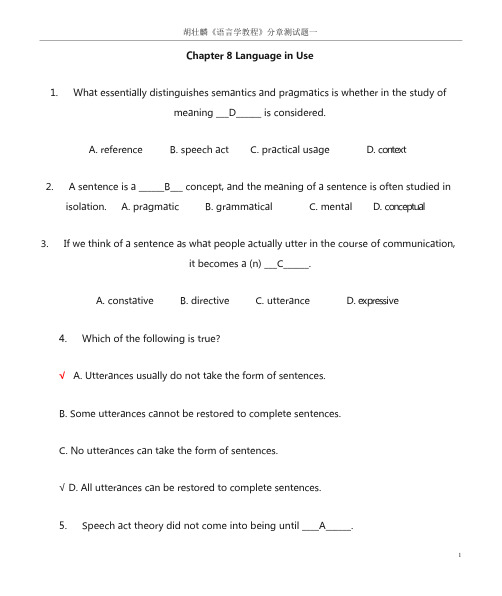
Chapter 8 Language in Use1. What essentially distinguishes semantics and pragmatics is whether in the study ofmeaning ___D______ is considered.A. referenceB. speech actC. practical usageD. co nte xt2. A sentence is a ______B___ concept, and the meaning of a sentence is often studied inisolation. A. pragmatic B. grammatical C. mental D. co nce p tual3. If we think of a sentence as what people actually utter in the course of communication,it becomes a (n) ___C______.A. constativeB. directiveC. utteranceD. e xp re ssive4. Which of the following is true?√ A. Utterances usually do not take the form of sentences.B. Some utterances cannot be restored to complete sentences.C. No utterances can take the form of sentences.√ D. All utterances can be restored to complete sentences.5. Speech act theory did not come into being until ____A______.A. in the late 50’s of the 20the centuryB. in the early 1950’sC. in the late 1960’sD. in the early 21st century6. ___C_______ is the act performed by or resulting fro m saying something; it is the consequence of, or the change brought about by the utterance.A. A locutionary actB. An illocutionary actC. A perlocutionary actD. A performative act7. According to Searle, the illocutionary point of the representative is ___B___.A. to get the hearer to do somethingB. to commit the speaker to something’s being the caseC. to commit the speaker to some future course of actionD. to express the feelings or attitude towards an existing state of affairs8. All the acts that belong to the sam e category share the same p urp ose, b ut they differ ___A__C_____.A. in their illocutionary actsB. in their intentions expressedC. in their strength or forceD. in their effect brought about9. _____A_____ is advanced by Paul GriceA. Cooperative PrincipleB. Politeness PrincipleC. The General Principle of Universal GrammarD. Adjacency Principle10. When any of the maxims under the cooperative principle is flouted, __D_____ might arise.A. impolitenessB. contradictionsC. mutual understandingD. conversational implicaturesII. Decide whether the following statements are true or false. (10%)11. F Pragmatics treats the meaning of language as something intrinsic and inherent.12.T It would be impossible to give an adequate description of meaning if the context of language use was left unconsidered.13.T What e sse ntially d isting uishe s se m antics and p rag m atics is whe the r in the stud y o fmeaning the context of use is considered.14. F The m ajor d ifference b etween a sentence and an utterance is that a sentence isnot uttered while an utterance is.15.F The meaning of a sentence is abstract, but context-dependent.16.F The meaning of an utterance is decontexualized, therefore stable.17T. F Utterances always take the form of complete sentences18. F Speech act theory was originated with the British philosopher John Searle.19.T Speech act theory started in the late 50’s of the 20th century.20.T Austin made the distinction between a constative and a performative.III. Fill in the blanks. (20%)21. The notion of ___context_______ is essential to the pragmatic study of language.22. If we think o f a sentence as what people actually utter in the course o f communication, it becomes an ___utterance_______.23. The meaning of a sentence is __abstrac t________, and decontexualized.24. _Constative_________ were statem ents that either state or d escrib e, and were thus verifiable.25. __Perfo rm ative_______ were sentences that d id no t state a fact o r d escrib e a state,and were not verifiable.26. A(n) __locuionary________ act is the act of uttering words, phrases, clauses. It is the act of conveying literal meaning by means of syntax, lexicon and phonology.27. A(n) ___illocutionary_______ act is the act o f e xp re ssing the sp e ake r’s inte ntio n; it isthe act performed in saying something.28. A(n) __commisive_______ is commit the speaker himself to some future course o f action.29. A(n) __expressive______ is to express feelings or attitude towards an existing state.30. There are four maxims under the cooperative principle: the maxim o f ____quantity______, the maxim of quality, the maxim of relation and the maxim of manner.IV. Explain the following terms, using examples. (20%)31. Conversational implicature32. Performative33. Locutionary act34. Q-principle (Horn)Ke y: Chapter8I. 1~5 DBCBA 6~10 CBCADII. 11~15 FTTFF 16~20 FFFTTIII. 21.context 22.utterance 23.abstract 24. Constatives25. Performatives 26. locutionary27. illocutionary 28. commissive 29. expressive 30. quantityChapter 12 Theories and Schools of Modern LinguisticsI. Choose the best answer. (20%)1. The p e rso n wh o is o fte n d e scrib e d as “fath e r o f m o d e rn lin g u istics” is __B________..A. FirthB. SaussureC. HallidayD. Cho m sky2. The m o st im p o rtant co ntrib utio n o f the Prag ue Scho o l to ling uistics is that it seeslanguage in terms of ___A_______.A. functionB. meaningC. signsD. syste m3. The principal representative of American descriptive linguistics is _______C__.A. BoasB. SapirC. BloomfieldD. Harris4. Generally sp eaking, the _____A_____ sp ecifies whether a certain tag m em e is in the position of the Nucleus or of the Margin in the structure.A. SlotB. ClassC. RoleD. Co he sio n5. _____A_____ Gram m ar is the m o st wid esp read and the b est und ersto o d m etho d o f discussing Indo-European languages.A. Trad itio nalB. StructuralC. FunctionalD. Ge ne rative6. ____A______ Gram m ar starte d fro m the Am e rican ling uist Syd ne y M. Lam b in the late 1950s and the early 1960s.A. StratificationalB. CaseC. RelationalD. Mo n tag u e7. In Hallid ay’s view, the _____B_____ function is the function that the child uses to know about his surroundings.A. personalB. heuristicC. imaginativeD. info rm ative8. The rheme in the sentence “On it stood Jane” is _____D_____.A. On itB. stoodC. On it stoodD. Jan e9. Chomsky follows _____C_____ in philosophy and mentalism in psychology.A. empiricismB. behaviorismC. relationalismD. m e ntalism10. TG grammar has seen _____C_____ stages of development.A. threeB. fourC. fiveD. sixII. Decide whether the following statements are true or false. (10%)11. F Following Saussure’s distinction between langue and parole, Trubetzkoy argued that phonetics belonged to langue whereas phonology belonged to parole.12. F The subject-predicate distinction is the same as the theme and rheme contrast.13. T London School is also known as systemic linguistics and functional linguistics.14.T According to Firth, a system is a set of mutually exclusive options that come into play at some point in a linguistic structure.15.F American Structuralism is a branch o f diachronic linguistics that emerged independently in the United States at the beginning of the twentieth century.16.F The Stan d ard Theo ry focuses discussion on language universals and universalg ram m ar.17.T American descriptive linguistics is empiricist and focuses on diversities o f languages.18.T Cho m sky’s co nce p t o f ling uistic p e rfo rm ance is sim ilar to Saussure’s co nce p t o fp aro le, while his u se o f lin g u istic co m p e te n ce is so m e what d iffe re n t fro m Sau ssu re’s lan g u e.19.T Glo sse m atics e m p hasize s the nature and status o f ling uistic the o ry and its re latio nto description.20. F If two sentences have exactly the same ideational and interpersonal functions, they would be the same in terms of textual coherence.III. Fill in the blanks. (20%)21. The Prague School practiced a special style of ___synchronic _______ Linguistics.22. The Prague School is best known and re m e m b e re d for its contribution to phonology and the distinction between __phonetics________ and phonology.23. The man who turned linguistics proper into a recognized distinct academic subject in Britain was _____Mathesius__﹙×﹚_J.R Firth_.24. Hallid ay’s Systemic Grammar contains a functional component, and the theory behind his Functional Grammar is ______systemic ___.25. Systemic-Functional Grammar is a(n) ___socially_sociogically______ orientedfunctional linguistic approach.26. Structuralism is b ased on the assum p tion that g ram m atical categ ories should b edefined not in terms of meaning but in terms of ___stucture___ distribution ____.27. In the history of Am erican ling uistics, the p eriod b etween 1933 and 1950 is also known as __Bloomfieldian________ Age.28. Descriptivism__________ in language theories is characteristic of America.29. The starting point o f Cho m sky’s TG grammar is his ____innateness______ hypothesis.30. Chomsky argues that LAD p ro b ab ly consists o f three elements, that is a __hypothesis maker________, linguistic universal, and an evaluation procedure.IV. Explain the following terms, using examples. (20%)31. FSP32. Cohesion33. LAD34. Case GrammarKe y: Chapter12I.1~5 BACAA 6~10 ABDCCII.11~15 FFTTF 16~20 FTTTFIII.21. synchronic 22. phonetics23. J. R. Firth 24. systemic25. sociologically 26. distribution27. Bloomfieldian 28. Descriptivism29. innateness 30. hypothesis-makerIV.31. FSP: It stands for Functional Sentence Pe rsp e ctive. It is a theory o f linguistic analysis which refers to an analysis o f utterances (o r texts) in term s o f the info rm atio n theycontain.*32. Co hesio n: The Co hesio n sho ws whether a certain tag m em e is d o m inating o ther tagmemes or is dominated by others.33. LAD: LAD, that is Language Acquisition Device, is posited by Chomsky in the 1960s as a d evice effectively p resent in the m ind s o f child ren b y which a g ram m ar o f their nativelanguage is constructed.*34. Case Gram m ar: It is an ap p roach that stresses the relationship of elem ents in a sentence. It is a type of generative grammar developed by C. J. Fillmore in the late 1960s。
《高级英汉翻译》课程终结考试试卷(样题及答案和评分标准)

《⾼级英汉翻译》课程终结考试试卷(样题及答案和评分标准)Get ready for the final exams of English/ChineseTranslation (1&2)Part I E-C Translation Test1. Composition of the Test Papers & useful skills in coping with the tests“⾼级英汉翻译”课程●评价⽬标:重点测试学⽣英汉笔译的技巧,包括增译法、减译法、词类转移法、词序调整法、分译法、重译法、正说反译,反说正译法和习语翻译等。
同时也考查相关的翻译理论知识、英语理解和汉语表达能⼒。
●命题原则:根据教材所涵盖的⽂章主题、体裁、翻译技巧以及与教材难度相当的书⾯语⾔材料命题。
英译汉的课外材料必须是从英语原著上选来的未经简化的⽂字。
涉及教材内容不少于50%。
●试题结构:“⾼级英汉翻译”课程终结考试试卷(样题)课程编号:ENBAE3 1001______ 学籍号:________________ 学习中⼼:________________ 姓名:________________ Information for the Examinees:This examination consists of FOUR sections. They are:Section I: Understanding of Theories (10 points, 15 minutes)Section II: Phrase Translation (25 points, 20 minutes)Section III: Sentence Translation (30 points, 25 minutes)Section IV: Passage Translation (35 points, 60 minutes)The total marks for this examination are 100 points. Time allowed forcompleting this examination is 2 hours (120 minutes)YOU MUST WRITE ALL YOUR ANSWERS ON THE ANSWER SHEET. Section I Understanding of Theories[10 points] Questions 1-10. (10 points)The following statements are about some translation theories you are familiar with. Decide whether these statements are true or false by writing T for "true" and F for "false" on your Answer Sheet.______1. Since Chinese and English belong to two different language families, one has to make some adjustments in lexicon and sentence structure to make the translated version smooth and natural.______2. Translating consists in reproducing in the receptor language the closest natural equivalent of the source-language message, first in terms of meaning and second in terms of style.______3. Every language adopts the same system of classifying its experience.______4. It widely agreed that there are three stages in the procedure of translation: analysis, transfer, and restructuring.______5. A word may have several meanings, but its linguistic context will help to point out the exact meaning of that word. ______6. Semotactic marking, one aspect of linguistic context, refers to the situation when the meaning of a word in a sentence is specified by the grammatical construction of that sentence.______7. In translating from English to Chinese, one must repeat key words including nouns, verbs, and pronouns.______8. In the process of transfer, the conceptual content of the message has the highest priority. Therefore, there is no need to keep the original form of the source-language text.______9. The situational factors relate to the occasion and circumstances of the speech event and to the relationships between speakers.______10. Nida believes that in testing the translation, one must focus attention not upon the extent of verbal correspondence but upon the amount of dynamic equivalence.Section II Phrase Translation[25 points]Part 1. Questions 11-20. (10 points)Choose a better version of Chinese translation for each of the following phrases. Write your answers on the Answer Sheet.11. the journey across AfricaA. 遍及⾮洲的旅⾏B. 穿越⾮洲的旅⾏12. be behind scheduleA. 落后于计划B. 在计划后⾯13. play the fluteA. 玩笛⼦B. 吹笛⼦14. black teaA. 红茶B. ⿊茶15. like a cat on hot bricksA. 烫砖上的猫B. 热锅上的蚂蚁16. a concept inconceivable beforeA. ⼀个以前⽆法想象的概念B. ⼀个概念,在以前⽆法想象17. Dutch treatA. 打平伙B. 荷兰式的招待18. political campaignA. 政治运动B. 竞选活动19. mountain lionA. ⼭狮B. 美洲豹20. an instrument designed to extend the range of people's sensesA. ⼀个⽤来拓展⼈们感觉范围的⼯具B. ⼀个⼯具,⽤来拓展⼈们的感觉范围Part 2. Questions 21-30. (15 points)Translate the following phrases and write your answers on the Answer Sheet.21. a hard question ____________________22. hard water ____________________23. the last ten-day period of a month ____________________24. a good Christian ____________________25. a well-managed company ____________________26. particles moving around their atomic nucleus ____________________27. generations of painstaking observation ____________________28. an unlikely coalition of university professors ____________________29. a computer genius ____________________30. as much with courtesy as with force ____________________Section III Sentence Translation [30 points]Questions 31-40: Translate the following sentences using the translation skills and techniques you have learned from this course. Write your answers on the Answer Sheet.31. Nobody could count on his restraint or rationality.____________________________________________________________32. Modern skyscrapers began to appear in the city, taking away much of its ancient charm and mystery, which was considered as a great pity by many people.____________________________________________________________33. The news had already spread along the streets and lanes.____________________________________________________________34. The examination left no doubt that the victim had not died of a heart attack but had been killed.____________________________________________________________35. There was no use arguing. The die was cast.____________________________________________________________36. Twentieth century history shows the impressive adaptive capacity of international relations based on multinational principles and norms.____________________________________________________________37. We are very grateful to you for your effort to come all the way from China to present his document to us.____________________________________________________________38. The problem of refugees should be dealt with in an integrated manner.____________________________________________________________39. It is exciting to visit your great country.____________________________________________________________40. No one was more willing to do a favor for friend or neighbour than he.____________________________________________________________Section IV Passage Translation[35 points]Part 1. Question 41. (15 points)The following passage is about problems with Darwinian Theory. Please translate it into Chinese on your Answer Sheet. You may refer to the new words and expressions provided in the box below.If Darwinian Theory works so well, why challenge it? There are several reasons to do so. Although Darwinian Theory explains many of the facts of evolution better than any other theory, it does not necessarily explain the whole process. Also, some of the results of evolution do not match what Darwinian Theory would predict.For example, if evolution leads to a perfect adaptation through natural selection acting on random hereditary changes, the process ought to slow down as it gets closer to the optimum for each species because fewer favorable changes can be made. Indeed, someorganisms-cockroaches and sponges, for example, are so well adapted that they have changed very little in many millions of years.Their evolutionary rate does seem to have slowed down. We should also see decrease in the number of species as they compete with one another and unsuccessful species are eliminated. But we see no such slowing down, and the number of species appears to be at least as great now as in the geologic past and perhaps even greater.Part 2. Question 42. (20 points)The following passage is an excerpt from a book talking about the special joys of slow reading. Please translate it into Chinese on your Answer Sheet.I discovered the worth of super-slow reading years ago. Previously, if I had been really interested in a book, I would race from page to page, eager to know what came next. Now, I decided, I had to become a miser with words and stretch every sentence like a poor man spending his last dollar. I had started with the practical object of making my book last. But by the end of the second week I began to realize how much I was getting fromsuper-slow-reading itself. Sometimes just a particular phrase caught my attention, sometimes a sentence. I would read it slowly, analyze it, read it again-perhaps changing down into an even lower gear-and then sit for 20 minutes thinking about it before moving on. I was like a pianist studying a piece of music, phrase by phrase, rehearsing it, trying to discover and recreate exactly what the composer was trying to convey.参考答案与评分标准(样题)Section I Understanding of Theories[10 points] Questions 1-10. (10 points, 1 point each)1.T2.T3. F4.T5.T6. F7. F8. F9.T 10.T Section II Phrase Translation[25 points] Part 1. Questions 11-20. (10 points, 1 point each) 11. B 12. A 13. B 14. A 15. B16. A 17. A 18. B 19. B 20. APart 2. Questions 21-30. (15 points, 1.5 points each.)Marking guide:评分标准(共15分,每个1.5分):1.译⽂应准确、完整。
简明英语语言学教程第二版第6章答案
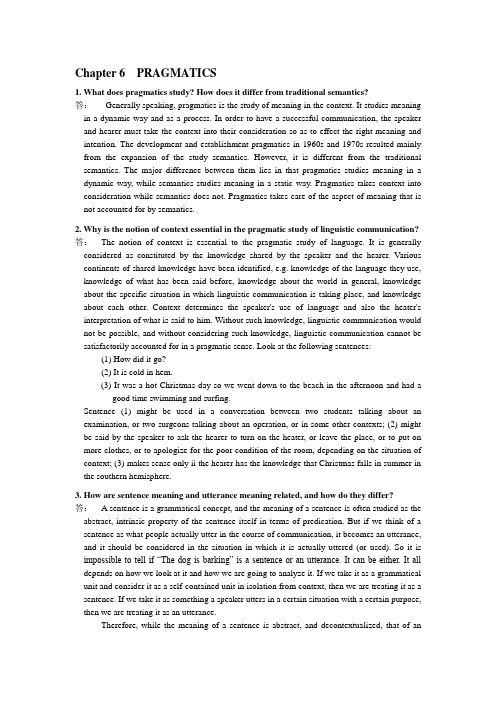
Chapter 6 PRAGMATICS1. What does pragmatics study? How does it differ from traditional semantics?答:Generally speaking, pragmatics is the study of meaning in the context. It studies meaning in a dynamic way and as a process. In order to have a successful communication, the speaker and hearer must take the context into their consideration so as to effect the right meaning and intention. The development and establishment pragmatics in 1960s and 1970s resulted mainly from the expansion of the study semantics. However, it is different from the traditional semantics. The major difference between them lies in that pragmatics studies meaning in a dynamic way, while semantics studies meaning in a static way. Pragmatics takes context into consideration while semantics does not. Pragmatics takes care of the aspect of meaning that is not accounted for by semantics.2. Why is the notion of context essential in the pragmatic study of linguistic communication? 答:The notion of context is essential to the pragmatic study of language. It is generally considered as constituted by the knowledge shared by the speaker and the hearer. Various continents of shared knowledge have been identified, e.g. knowledge of the language they use, knowledge of what has been said before, knowledge about the world in general, knowledge about the specific situation in which linguistic communication is taking place, and knowledge about each other. Context determines the speaker's use of language and also the heater's interpretation of what is said to him. Without such knowledge, linguistic communication would not be possible, and without considering such knowledge, linguistic communication cannot be satisfactorily accounted for in a pragmatic sense. Look at the following sentences:(1) How did it go?(2) It is cold in hem.(3) It was a hot Christmas day so we went down to the beach in the afternoon and had agood time swimming and surfing.Sentence (1) might be used in a conversation between two students talking about an examination, or two surgeons talking about an operation, or in some other contexts; (2) might be said by the speaker to ask the hearer to turn on the heater, or leave the place, or to put on more clothes, or to apologize for the poor condition of the room, depending on the situation of context; (3) makes sense only ii the hearer has the knowledge that Christmas falls in summer in the southern hemisphere.3. How are sentence meaning and utterance meaning related, and how do they differ?答: A sentence is a grammatical concept, and the meaning of a sentence is often studied as the abstract, intrinsic property of the sentence itself in terms of predication. But if we think of a sentence as what people actually utter in the course of communication, it becomes an utterance, and it should be considered in the situation in which it is actually uttered (or used). So it is impossible to tell if “The dog is barking” is a sentence or an utterance. It can be either. It all depends on how we look at it and how we are going to analyze it. If we take it as a grammatical unit and consider it as a self-contained unit in isolation from context, then we are treating it as a sentence. If we take it as something a speaker utters in a certain situation with a certain purpose, then we are treating it as an utterance.Therefore, while the meaning of a sentence is abstract, and decontextualized, that of anutterance is concrete, and context-dependent. The meaning of an utterance is based on sentence meaning; it is the realization of the abstract meaning of a sentence in a real situation of communication, or simply in a context. Now, take the sentence "My bag is heavy" as an example. Semantic analysis of the meaning of the sentence results in the one-place predication BAG (BEING HEA VY). Then a pragmatic analysis of the utterance meaning of the .sentence varies with the context in which it is uttered. For example, it could be uttered by a speaker as a straightforward statement, telling the hearer that his bag is heavy. It could also be intended by the speaker as an indirect, polite request, asking the hearer to help him carry the bag. Another possibility is that the speaker is declining someone's request for help. All these are possible interpretations of the same utterance “M y bag is heavy”. How it is to be underst ood depends on the context in which it is uttered and the purpose for which the speaker utters it.While most utterances take the form of grammatically complete sentences, some utterances do not, and some cannot even be restored to complete sentences.4. Try to think of contexts in which the following sentences can be used for other purposes than just stating facts:a) The room is messy.b) Oh, it is raining!c) The music of the movie is good.d) You have been keeping my notes for a whole week now.答:a) A father entered his son’s room and found it is very messy. Then when he said, “The room is messy,” he was blaming his son for not tidying it up.b) A son asked his father to play with him outside. So when the father said, “Oh, it’s raining”,he meant they couldn’t play outside.c) Two persons just watched a movie and had a discussion of it. One person sai d, “The story ofthe movie is very moving”, so wh en the other person sai d, “The music of the movie is good”, he me ant he didn't think the story of the movie was good.d) A person wanted his notes bac k, so when he said, “you ha ve been keeping my notes for awhole wee k now”, he was demanding the return of his notes.5. According to Austin, what are the three acts a person is possibly performing while making an utterance. Give an example.答:According to Austin's new model, a speaker might be performing three acts simultaneously when speaking: locutionary act, illocutionary act, and perlocutionary act.A locutionary act is the act of uttering words, phrases, clauses. It is the act of conveying literal meaning by means of syntax, lexicon and phonology. An illocutionary act is the act of expressing the speaker’s intention; it is the act performed in saying something. A perlocutionary act is the act performed by or resulting from saying something; it is the consequence of, or the change brought about by the utterance; it is the act performed by saying something. Let's look at an example:You have left the door wide open.The locutionary act performed by the speaker is his utterance of the wo rds “you”, “have”, “door”, “open”, etc. thus expressing what the words literally mean.The illocutionary act performed by the speaker is that by making such an utterance he has expressed his intention of speaking, i.e. asking someone to close the door, or making acomplaint, depending on the context.The perlocutionary act refers to the effect of the utterance. If the hearer gets the speaker's message and sees that the speaker means to tell him to close the door, the speaker has successfully brought about the change in the real world he has intended to; then the perlocutionary act is successfully performed.6. What are the five types of illocutionary speech acts Searle has specified? What is theillocutionary point of each type?答:(1) representatives: stating or describing, saying what the speaker believes to be true(2) directives: trying to get the hearer to do something(3) commissives: committing the speaker himself to some future course of action(4) expressives: expressing feelings or attitude towards an existing(5) declarations: bringing about immediate changes by saying somethingThe illocutionary point of the representatives is to commit the speaker to something's being the case, to the truth of what has been said, in other words, when performing an illocutionary act of representative, the speaker is making a statement or giving a description which he himself believes to be true. Stating, believing, sweating, hypothesizing are among the most typical of the representatives.Directives ate attempts by the speaker to get the hearer to do some- thing. Inviting, suggesting, requesting, advising, wanting, threatening and ordering are all specific instances of this class.Commissives are those illocutionary acts whose point is to commit the speaker to some future course of action, i.e. when speaking the speaker puts himself under a certain obligation. Promising, undertaking, vowing are the most typical ones.The illocutionary point of expressives is to express the psychological state specified in the utterance. The speaker is expressing his feelings or attitudes towards an existing state of affairs, e.g. apologizing, thanking, congratulating.The last class “declarations” has the characteristic that the successful performance of an act of this type brings about the correspondence between what is said and reality.7. What is indirect language use? How is it explained in the light of speech act theory?答:When someone is not saying I an explicit and straightforward manner what he means to say, rather he is trying to put across his message in an implicit, roundabout way, we can say he is using indirect language.Explanation (略) (见教材p.84-85)8. What are the four maxims of the CP? Try to give your own examples to show how floutingthese maxims gives rise to conversational implicature?答:Cooperative Principle, abbreviated as CP. It goes as follows:Make your conversational contribution such as required at the stage at which it occurs by the accepted purpose or direction of the talk exchange in which you are engaged.To be more specific, there are four maxims under this general principle:(1) The maxim of quantity①Make your contribution as informative as required (for the current purpose of theexchange).②Do not make your contribution more informative than is required.(2) The maxim of quality①Do not say what you believe to be false.②Do not say that for which you lack adequate evidence.(3) The maxim of relationBe relevant.(4) The maxim of manner①Avoid obscurity of expression.②Avoid ambiguity.③Be brief (avoid unnecessary prolixity).④Be orderly.9. What is pragmatic failure? Try to find instances of pragmatic failure in the English usedby Chinese learners of English.答:The technical term for breakdowns in the course of communication is pragmatic failure.Pragmatic failure occurs when the speaker fails to use language effectively to achieve a specific communication purpose, or when the hearer fails to recognize the intention or the illocutionary force of the speaker’s utterance in the context of communication.Instances (略) (见教材p.89)。
小升初英语必考知识点归纳
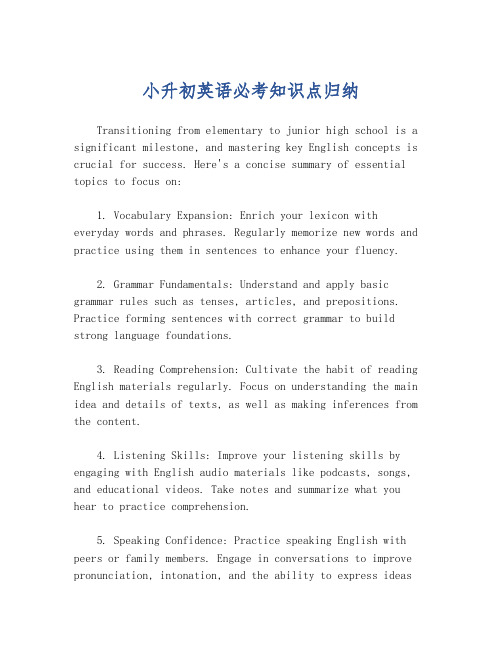
小升初英语必考知识点归纳Transitioning from elementary to junior high school is a significant milestone, and mastering key English concepts is crucial for success. Here's a concise summary of essential topics to focus on:1. Vocabulary Expansion: Enrich your lexicon with everyday words and phrases. Regularly memorize new words and practice using them in sentences to enhance your fluency.2. Grammar Fundamentals: Understand and apply basic grammar rules such as tenses, articles, and prepositions. Practice forming sentences with correct grammar to build strong language foundations.3. Reading Comprehension: Cultivate the habit of reading English materials regularly. Focus on understanding the main idea and details of texts, as well as making inferences from the content.4. Listening Skills: Improve your listening skills by engaging with English audio materials like podcasts, songs, and educational videos. Take notes and summarize what you hear to practice comprehension.5. Speaking Confidence: Practice speaking English with peers or family members. Engage in conversations to improve pronunciation, intonation, and the ability to express ideasclearly.6. Writing Skills: Write short essays, diary entries, or summaries in English. Pay attention to sentence structure, punctuation, and coherence to develop clear and effective writing.7. Idiomatic Expressions: Learn common idiomatic expressions and phrases to sound more natural and fluent in English. Use them in context to understand their meanings and applications.8. Cultural Awareness: Familiarize yourself with English-speaking cultures to better understand the context of language use. This will aid in comprehension and communication.。
自学考试《现代语言学》自测试题带答案
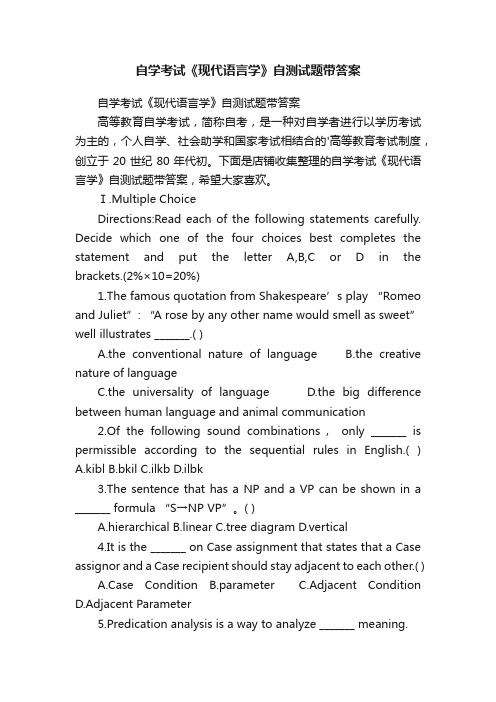
自学考试《现代语言学》自测试题带答案自学考试《现代语言学》自测试题带答案高等教育自学考试,简称自考,是一种对自学者进行以学历考试为主的,个人自学、社会助学和国家考试相结合的'高等教育考试制度,创立于20世纪80年代初。
下面是店铺收集整理的自学考试《现代语言学》自测试题带答案,希望大家喜欢。
Ⅰ.Multiple ChoiceDirections:Read each of the following statements carefully. Decide which one of the four choices best completes the statement and put the letter A,B,C or D in the brackets.(2%×10=20%)1.The famous quotation from Shakespeare’s play “Romeo and Juliet”: “A rose by any other name would smell as sweet” well illustrates _______.( )A.the conventional nature of languageB.the creative nature of languageC.the universality of languageD.the big difference between human language and animal communication2.Of the following sound combinations,only _______ is permissible according to the sequential rules in English.( )A.kiblB.bkilC.ilkbD.ilbk3.The sentence that has a NP and a VP can be shown in a _______ formula “S→NP VP”。
英语教学论lexis的名词解释

英语教学论lexis的名词解释Lexis.Definition.Lexis refers to the vocabulary of a language, including the words, phrases, and idioms that make up its lexicon. It encompasses all the lexical units that are used to convey meaning in a given language.Importance in English Teaching.Lexis plays a crucial role in English teaching, serving as the building blocks for communication. A comprehensive understanding and productive use of vocabulary areessential for effective language acquisition and communication.Types of Lexis.Lexis can be classified into various types based on its function, form, and usage:Content words: Lexical items that carry the primary meaning of a sentence, such as nouns, verbs, adjectives, and adverbs.Function words: Lexical items that play a grammatical role, such as prepositions, conjunctions, determiners, and auxiliary verbs.Open-class words: Lexical items that can be added to the language, such as new nouns, verbs, and adjectives.Closed-class words: Lexical items that are fixed in number and cannot be easily expanded, such as prepositions and conjunctions.Single words: Lexical items that consist of one word, such as "dog" or "run."Multi-word units: Lexical items that consist of two ormore words, such as "phrase" or "idiom."Teaching Lexis.Effective teaching of lexis involves a multifaceted approach that includes:Vocabulary development: Introducing new words and phrases to learners through various methods, such as reading, listening, and speaking activities.Meaning exploration: Facilitating learners' understanding of the meanings of words through discussions, definitions, and context-based activities.Collocation building: Teaching learners the typical combinations of words that occur together, such as "make a decision" or "get on a bus."Idiom understanding: Introducing idiomatic expressions and explaining their figurative meanings and usage.Vocabulary consolidation: Providing opportunities for learners to practice and reinforce vocabulary through exercises, games, and authentic communication tasks.Assessment of Lexis.Assessing learners' lexical knowledge and skills involves:Vocabulary tests: Testing learners' recognition and understanding of words and their meanings through fill-in-the-blank, matching, and multiple-choice exercises.Collocation assessment: Assessing learners' ability to produce and recognize typical word combinations.Idiom comprehension: Testing learners' understanding and use of idioms through sentence completion and interpretation tasks.Vocabulary fluency: Measuring learners' ability to retrieve and use vocabulary in spontaneous speech orwriting.Conclusion.Lexis forms the foundation of language learning, enabling learners to express ideas, understand others, and engage in meaningful communication. Effective English teaching involves a systematic and comprehensive approach to vocabulary instruction, fostering learners' ability to acquire, understand, and use lexis effectively.。
福师1203考试批次《现代语言学》复习题及参考答案
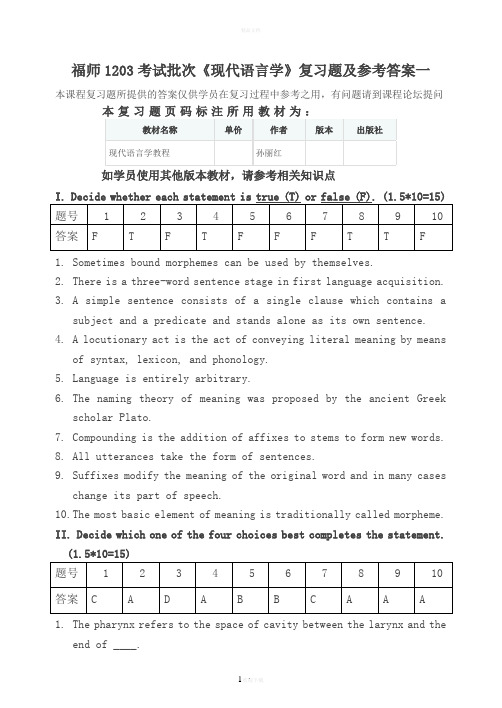
福师1203考试批次《现代语言学》复习题及参考答案一本课程复习题所提供的答案仅供学员在复习过程中参考之用,有问题请到课程论坛提问如学员使用其他版本教材,请参考相关知识点1.Sometimes bound morphemes can be used by themselves.2.There is a three-word sentence stage in first language acquisition.3. A simple sentence consists of a single clause which contains asubject and a predicate and stands alone as its own sentence. 4. A locutionary act is the act of conveying literal meaning by meansof syntax, lexicon, and phonology.nguage is entirely arbitrary.6.The naming theory of meaning was proposed by the ancient Greekscholar Plato.pounding is the addition of affixes to stems to form new words.8.All utterances take the form of sentences.9.Suffixes modify the meaning of the original word and in many caseschange its part of speech.10.The most basic element of meaning is traditionally called morpheme. II. Decide which one of the four choices best completes the statement.1.The pharynx refers to the space of cavity between the larynx and theend of ____.A. tongueB. hard palateC. soft palateD. vocal cords2.Morphemes that represent “tense”, “number”, “gender”,“case” and so forth are called ____ morphemes.A. inflectionalB. boundC. freeD. derivational3. The fact that ability to speak a language is transmitted from generation to generation by a process of learning, and not genetically is usually referred to as ____.A. performanceB. language acquisitionC. cultural transmissionD. competence4. The sound [s] and [z] are the results of air escaping under frication between tongue and ____ before passing through the teeth.A. hard palateB. uvulaC. alveolar ridgeD. soft palate5.____ deals with language application to other fields, particularlyeducation.A. Linguistic geographyB. Applied linguisticsC. SociolinguisticsD. Comparative linguistics6. Vowels that are produced between the positions for a front and back vowel are called ____ vowels.A. openB. closeC. frontD. central7、______ is defined as a conscious process of accumulating knowledge of a second language usually obtained in school settings.A. CompetenceB. PerformanceC. LearningD. Acquisition8、______ act theory is an important theory in the pragmaticstudy of language.A. SpeakingB. SpeechC. SoundD. Spoken9. A ______ analysis of an utterance will reveal what thespeaker intends to do with it.A. semanticB. syntacticC. pragmaticD. grammatical10.The most basic element of meaning is traditionally callen______A. morphemeB. syntacticC. pragmaticD. grammaticalIII. Dissect the following words into morphemes. (2*5=10)1. though _______________ _______考核知识点:morpheme,参见P19-222. speeches _________________ _____ 考核知识点:morpheme,参见P19-223. geography ___________ ___________ 考核知识点:morpheme,参见P19-224、morpheme___________ ___________ 考核知识点:morpheme,参见P19-225、syntactic___________ ___________ 考核知识点:morpheme,参见P19-22IV. Define the following terms. (5*6=30)1. the telegraphic stage考核知识点:language acquisition,参见P482. language考核知识点:language ,参见P33. discreteness考核知识点:discreteness参见P94. vowel考核知识点:vowel,参见P145. internal structure考核知识点:internal structure,参见P22V. Answer the following questions. (15*2=30)1. Why do we say language is arbitrary?考核知识点:arbitrary,参见P5参考答案要点:Arbitrariness in narrow sense refers to the lack of physical,logical or natural connection(i.e.the inexplicability of the relationship)between individual linguistic symbols and the meanings they symbolize.We know people use linguistic symbols which are originally meaningless to refer to something meaningful.There is no physical,’logical or natural connection between the symbolic signs used in language and the meaning they stand for.It is inexplicable.Wecan’t explain why the English people use‘'water'’to refer to the stuff in this bottle.Similarly,we can’t explain why the Chinese people use“水”to refer to the stuff.So language is arbitrary in nature.2. What’s the difference between langue and parole?考核知识点:langue and parole,参见P3-10参考答案要点:Language is full ofvarieties:no two speakers speak in an identical manner;no two speakers have an identical learning experience.Language consists in its varieties,that is to say,language is realized through its varieties(cp.the relation.between fruit and apple,between phoneme and allophones and phones and between langue and parole.福师1203考试批次《现代语言学》复习题及参考答案二本课程复习题所提供的答案仅供学员在复习过程中参考之用,有问题请到课程论坛提问如学员使用其他版本教材,请参考相关知识点I. Decide whether each statement is true (T) or false (F). (15 points,1.5 points for each)1、Linguistics is generally defined as the scientific study of language..2、Language is not only linearly-structured.3、Linguistic performance is essentially a social phenomenon and alsoa context-dependent behavior.4、General linguistics studies the basic concepts, theories,5、descriptions, models and methods applicable are not in any linguistic study.6、Some languages are not superior to other languages.7、Compounding is the addition of affixes to stems to form new words.8、 Not all utterances take the form of sentences.9、Morphemes modify the meaning of the original word and in many cases change its part of speech.10、The most basic element of meaning is traditionally called morphe. 参考答案:1-5 F T F T F 6-10 T F T T FII. Choose the ONE choice that best completes each statement. (20 points,2 points for each)1.Whcih of the following best states the behaviorist view of childlanguage acquisition?_______.A. Language acquisition is a process of habit formationB. Language acquisition is the species-specific property of humanbeingsC. Children are born with an innate ability to acquire languageD. Humans are equipped with the neural prerequisites for language and language use参考答案B2.The pair of words "lend"and "borrow"are ___.A.gradable oppositesB.relational oppositesC.co-hyponymsD.synonyms参考答案B3. The discovery of Indo-European language family began with the workof the British scholar .A.Jacob GrimmB.Rasmus RaskC.Franz BoppD.Sir William Jones参考答案D4. A linguist regards the changes in language and language use as __.A.unusualB.something to be fearedC.abnormalD.natural参考答案D5. __produce fast and fluent speech with good intonation andpronunciation but the content of their speech ranges from mildly inappropriate to complete nonsense,often as unintelligible.A.Broca"s aphasicB.The linguistic deprivationC.The damage on the angular gyrusD.Wernicke"s aphasic参考答案D6.Some Southern learners of English in China tend to say "night" as"light".This shows: .A.They cannot pronounce/n/B. Interlangue interference because there is notthe sound /n/in theirmother tongueC.The teachers do not have a good teaching methodD.They do not like to pronounce nasal sounds参考答案B7.. A word with several meanings is called __word.A.a polysemousB.a synonymousC.an abnormalD.a multiple参考答案A8.. The function of the sentence "A nice day, isn"t it?"is __.rmativeB.phaticC.directiveD.performative参考答案B9. The most recognizable differences between American English andBritish English are in __ and vocabulary.ageB.grammarC.pronunciationD.structure 参考答案C10. __deals with the way in which a language varies through geographicalspace.A.Linguistic geographyB.LexicologyC.LexicographyD.Sociolinguistics参考答案AIII. Define each of the following terms. (30 points, 6 points for each) 1. phonetics考核知识点:phonetics,参见P122. phoneme考核知识点:phoneme,参见P163. stress考核知识点:stress,参见P174.reference考核知识点:reference,参见P355. idiolect考核知识点:idiolect,参见P41Answer the following questions. (35 points)1. How, in your opinion, does pragmatics differ from semantics?考核知识点:pragmatics and semantics,参见P28-35参考答案要点:Pragmatics is the study of the meaning which is not included in semantics and whose interpretation is dependent on its social contexts.Semantics is the science of meaning.Semantics is concemed t11 encoding and decoding of meaning,(finding out how people encode their meaning and how people try to interpret their meaning),identifying and classifying meanings,lexical meaning,sentential meaning,and utterance2. What’s the difference between sense and reference?考核知识点:sense and reference,参见P35参考答案要点:There are two different meanings of meaning:sense(the meaning that relates linguistic forms with what is in the non.1inguisticworld)and reference(the meaning that lies in the relation or contrasts among linguistic forms themselves,i.e.how the meanings are divided by the different linguistic forms/how different linguistic forms may be used to express meanings).3. Explain language production with some examples.考核知识点:language production,参见P51参考答案要点:Language production is more difficult to study than language comprehension for the following reasons:the way thoughts are turned into speech(We don’t know how thoughts are turned intospeech.);indirect approach through analyzing errors in speech production(We can only use this indirect approach to infer from these errors how we produce speech.)Following Carroll’s model of speech production,there are four stages:construction of thought to be expressed(You must have something in your mind to be expressed),formation ofthought into linguistic forms(When you have some thought,you should turn it into linguistic forms),construction of a motor command for the utterance(You need to prepare the command for the speech organs to speak),execution ofthat motor command(You’re actually saying what you want to say).福师1203考试批次《现代语言学》复习题及参考答案三本课程复习题所提供的答案仅供学员在复习过程中参考之用,有问题请到课程论坛提问如学员使用其他版本教材,请参考相关知识点I. Decide whether each statement is true (T) or false (F). (15 points,1.5 points for each)11.Sometimes bound morphemes can be used by themselves.12.There is a three-word sentence stage in first language acquisition.13.A simple sentence consists of a single clause which contains asubject and a predicate and stands alone as its own sentence. 14.A locutionary act is the act of conveying literal meaning by meansof syntax, lexicon, and phonology.nguage is entirely arbitrary.16.Articulatory phonetics that studies speech sounds from a physicalpoint of view, focusing on their physical properties intransmission.17.In speech sound production, lower part of the oral cavity arerelatively stable and function as a foil to the upper part in itsarticulatory movements.18.Consonants are sounds made by a closure or narrowing somewhere inthe vocal tract.19.Stress may play different functions in different languages.20.Affixation changes the grammatical class of the word.参考答案1-5 F T F T F 6-10 F F T T FII. Choose the ONE choice that best completes each statement. (20 points, 2 points for each)3.The pharynx refers to the space of cavity between the larynx and theend of ______.A. tongueB. hard palateC. soft palateD. vocal cords4.Morphemes that represent “tense”, “number”, “gender”,“case” and so forth are called ______ morphemes.A. inflectionalB. boundC. freeD. derivational3. The fact that ability to speak a language is transmitted fromgeneration to generation by a process of learning, and not geneticallyis usually referred to as ______.A. performanceB. language acquisitionC. cultural transmissionD. competence4. The sound [s] and [z] are the results of air escaping under fricationbetween tongue and ______ before passing through the teeth.A. hard palateB. uvulaC. alveolar ridgeD. soft palate6.______ deals with language application to other fields, particularlyeducation.A. Linguistic geographyB. Applied linguisticsC. SociolinguisticsD. Comparative linguistics6. Language has that distinguish it from other semiotic systemsused by humans and animals.A. functionB. design featuresC. importanceD. performance7. the main source of energy for speaking, initiating the airflowfor speech, hence pulmonic airstream mechanism.A. MouthB. HeartC. NoseD. Lung8. The phones that can be grouped together as variants of one phonemehave to be similarA. phoneticallyB. phonologicallyC. soundD. seem9. morpheme is a morpheme that contributes to the lexical meaningof the word.A. FunctionalB. LexicalC. GrammaticalD. Performative10. According to , language determines the framework of speaker’sperception and thought.A. Sapir-Whorf HypothesisB. Positivist theoryC. Use theoryD. Speech Acts theory 参考答案1-5 C A D A B 6-10 B D AB AIII. Define each of the following terms. (30 points, 6 points for each) 1. pragmatics考核知识点:pragmatics,参见P352. semantics考核知识点:semantics,参见P283. phonology考核知识点:phonology,参见P154. linguistics考核知识点:linguistics,参见P105. syntax考核知识点:syntax,参见P22Answer the following questions. (35 points)1. What is psycholinguistics?考核知识点:psycholinguistics,参见P48参考答案要点:Psycholinguistics is the study of the relation between language and mind,especially language acquisition and learning,and language comprehension and production.2. What’s the difference between free morpheme and bound morpheme? 考核知识点:free morpheme and bound morpheme,参见P20参考答案要点:Morpheme may also be classified according to their role in word formation.Inflectional morpheme is a bound morpheme that shows the inflectional changes of the wordand that expresses a certain grammatical meaning.Most of inflectional morphemes in English arerealized through their allomorphs,e.g.{past tense}-->一ed,一d,…An inflectional morpheme doesnot change the grammatical class ofthe word,e.g.{change)change is a verb,and{change)+{pasttense)is still a verb.Derivational morpheme is a morpheme that is added to a word to form a new word.Derivational morpheme may be a bound morpheme such as affixes,but it may also be a freemorpheme such as those used to form a compound.There are six key terms used in derivational3. Explain pidgin and creole with some examples.考核知识点:pidgin and creole,参见P43参考答案要点:Pidgin refers to a kind of lingua franca which is also known as“marginal language”.It has areduced grammatical structure,lexicon and stylistic range and has no native speakers.Theformation of a pidgin usually involves two or more speech communities and requires considerable motivation on the part of the speaker.Pidgin usually flourishes in areas of economic development and of substantial trading among different speech communities.Pidgin English used in trading among the English and the Chinese in Shanghai in the old days.Pidgin English used in Asia in trading includes elements from Malay,Chinese and精品文档。
in contrast with 阅读理解
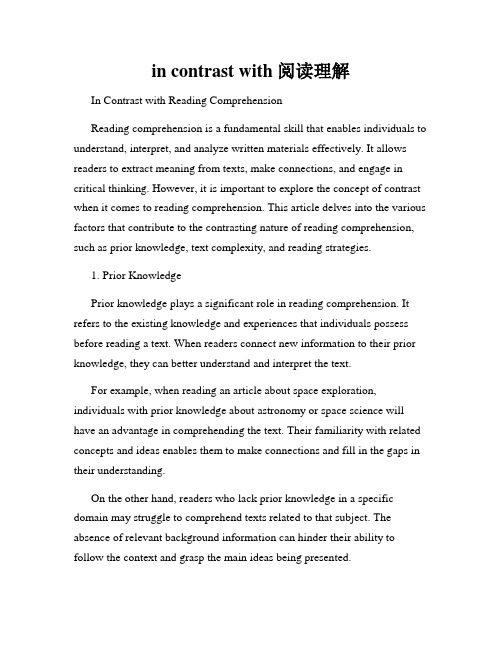
in contrast with 阅读理解In Contrast with Reading ComprehensionReading comprehension is a fundamental skill that enables individuals to understand, interpret, and analyze written materials effectively. It allows readers to extract meaning from texts, make connections, and engage in critical thinking. However, it is important to explore the concept of contrast when it comes to reading comprehension. This article delves into the various factors that contribute to the contrasting nature of reading comprehension, such as prior knowledge, text complexity, and reading strategies.1. Prior KnowledgePrior knowledge plays a significant role in reading comprehension. It refers to the existing knowledge and experiences that individuals possess before reading a text. When readers connect new information to their prior knowledge, they can better understand and interpret the text.For example, when reading an article about space exploration, individuals with prior knowledge about astronomy or space science will have an advantage in comprehending the text. Their familiarity with related concepts and ideas enables them to make connections and fill in the gaps in their understanding.On the other hand, readers who lack prior knowledge in a specific domain may struggle to comprehend texts related to that subject. The absence of relevant background information can hinder their ability to follow the context and grasp the main ideas being presented.2. Text ComplexityThe complexity of a text also impacts reading comprehension. Text complexity refers to the level of difficulty presented by the vocabulary, sentence structure, and overall content of the text. A text that is too complex can pose challenges for readers, leading to decreased comprehension.Complex texts often contain unfamiliar words, technical jargon, or complex sentence structures. This can make it difficult for readers to decode and comprehend the text effectively. It is crucial to strike a balance between challenging readers to expand their skills and overwhelming them with incomprehensible texts.Teachers and educators play a crucial role in selecting appropriate texts that align with the reading abilities and interests of their students. By providing texts that offer a gradual increase in complexity, educators can support students' reading comprehension development.3. Reading StrategiesEffective reading strategies play a vital role in enhancing reading comprehension. Readers can employ various strategies to improve their understanding while reading. Some common strategies include:- Previewing: Skimming through the text before reading it in detail, allowing readers to gain a general understanding of the content and structure.- Making predictions: Using prior knowledge and clues within the text to make educated guesses about what might happen next or the main ideas being conveyed.- Summarizing: Condensing the main ideas and important details of a text into a concise summary, aiding in comprehension and retention of information.- Questioning: Engaging in an active dialogue with the text by asking questions, identifying areas of confusion, and seeking clarification.Furthermore, metacognitive strategies, which involve monitoring and regulating one's own thinking during reading, can also significantly contribute to reading comprehension. Metacognitive strategies include self-reflection, self-questioning, and self-correction, allowing readers to actively engage with the text and assess their understanding.In contrast, ineffective reading strategies, such as passive reading or lack of engagement, can hinder comprehension and result in superficial understanding of the text.In conclusion, reading comprehension is a complex process influenced by various factors. Prior knowledge, text complexity, and reading strategies all contribute to the contrasting nature of reading comprehension. By understanding these factors and employing effective strategies, individuals can enhance their reading comprehension skills, enabling them to engage with texts more deeply, think critically, and extract meaning effectively.。
汉语言文学综合测试三
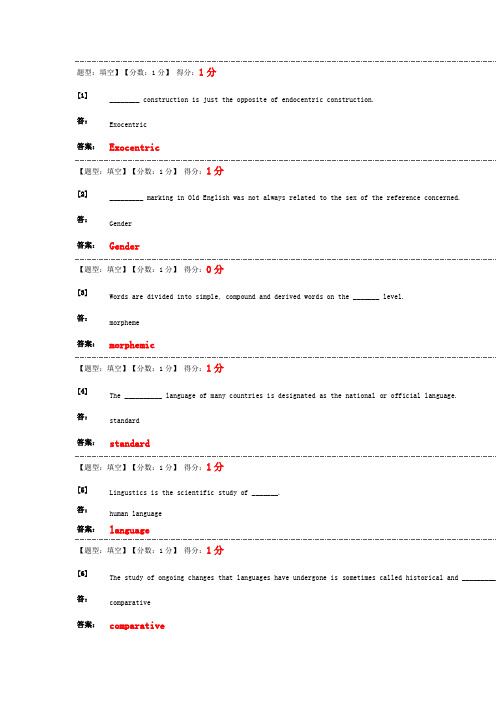
[1]________ construction is just the opposite of endocentric construction.答:Exocentric答案:Exocentric【题型:填空】【分数:1分】得分:1分[2]_________ marking in Old English was not always related to the sex of the reference concerned.答:Gender答案:Gender【题型:填空】【分数:1分】得分:0分[3]Words are divided into simple, compound and derived words on the _______ level.答:morpheme答案:morphemic【题型:填空】【分数:1分】得分:1分[4]The __________ language of many countries is designated as the national or official language.答:standard答案:standard【题型:填空】【分数:1分】得分:1分[5] Lingustics is the scientific study of _______.答:human language答案:language【题型:填空】【分数:1分】得分:1分[6]The study of ongoing changes that languages have undergone is sometimes called historical and _________答:comparative答案:comparative[7]The pre-school years are a __________ period for first language acquisition.答:crucial答案:critical【题型:填空】【分数:1分】得分:1分[8]A _______ act is an act of uttering word, phrases, clauses. It is the act of conveying literal meaning by meanand phonology.答:prelocutionary答案:locutionary【题型:填空】【分数:1分】得分:1分[9]Consonants differ from vowels in that the latter are produced without_________.答:obstruction答案:obstruction【题型:填空】【分数:1分】得分:1分[10]"Charge" and "accuse" are said to be _______ synonyms.答:collocational答案:collocational【题型:名词解释】【分数:3分】得分:2分[11]Minimal pair答:When two different phonetic forms are identical in every way except in one sound element that occurs in the string, the two form are said two form a minimal pair.答案:When two different phonetic forms are identical in every way except in one sound elem in the same position in the string, the two forms are said two form a minimal p 【题型:名词解释】【分数:3分】得分:3分Telegraphic speech答:Children’s telegraphic speech :Children's early multiword speech that contains content words and lacks function w morphemes that contains content words and lacks function words and inflectional morphemes答案:Children's telegraphic speech: Children's early multiword speech that contains co lacks function words and inflectional morphemesthat contains content words and lacks and inflectional morphemes.【题型:名词解释】【分数:3分】得分:0分[13]Illocutionary act答:The illocutionary act is the act performed in the performing of a locutionary act. When we speak we not onl of language with certain meanings, but also make clear our purpose in producing them, the way we intend th or they also have certain forces as Austin prefers to say. In the example of “Morning!” we can say it has the or it ought to have been taken as a greeting.答案:It is using a sentence to perform a function. for example, shoot the snake may an order or a piece of advice【题型:名词解释】【分数:3分】得分:2分[14] Design features答:Design features refers to defining properties of human language that distinguish it from any other animal system of are arbitrarinessp roductivity,displacement,cultural teansimission.答案:Design features refers to defining properties of human language that distinguish it from any system of communication. They are arbitrariness, productivity, duality, displacement, cultura 【题型:名词解释】【分数:3分】得分:3分[15]Ethnic dialect答:It is a social dialect of a language, often cutting across regional difference.It is spoken mainly by a less p that has experienced some form of social isolation, such as racial discrimination or segregation.答案:It is a social dialect of a language, often cutting across regional differences. It i by a less privileged population that has experienced some form of social isolation, discrimination or segregation.【题型:名词解释】【分数:3分】得分:2分Back clipping答:It means one or more are deleted form the end of the word.It is the most common type of clipping, like au 答案:It means one or more are deleted from the end of the word. It is the most common ty like auto from automobile.【题型:名词解释】【分数:3分】得分:3分[17]Truth condition答:It is the fact that would have to obtain in reality to make a proposition true or false.答案:It is the fact that would have to obtain in reality to make a proposition tr 【题型:名词解释】【分数:3分】得分:3分[18]Registers答:Language varieties appropriate for use in particular speech situations, in contrast to language varieties that the social or regional grouping of their customary users. Registers are also called situational dialects. 答案:language varieties appropriate for use in particular speech situations, in contr varieties that are associated with the social or regional grouping of their cust Registers are also called situational dialects【题型:名词解释】【分数:3分】得分:3分[19]vowel答:A vowel is a sound in forming which the air that comes from the lungs meets with no obstruction of any kinnose or the mouth.答案:A vowel is a sound in forming which the air that comes from the lungs meets with of any kind in the throat, the nose or the mouth.【题型:名词解释】【分数:3分】得分:2分[20]Predication答:Predication is the abstraction of the meaning of a sentence. It is the basic unit in the semantic analysis predication consist of argument and predicate.答案:Predication is the abstraction of the meaning of a sentence. It is the basic unitanalysis of the a sentence. A predication consist of argument and predicate. 【题型:简答】【分数:10分】得分:4分[21]What is the difference between a pidgin and Creole?答:A pidgin is a variety of language that is generally used by native speak-ers of other languages as a mediA pidgin is used for some practical pur-poses, such as trading, by groups of people who do not know each otis not a native lan-guage of a particular region, but only a marginal language used by people whose cultures a and whose business contact is very spe-cialized. As a simplified language, a pid-gin involves reductions i and syntax. Although pidgins are simplified languages, they are rule-governed.答案:variety of language|native speakers|medium of communication|practical purpose| language|some speech community【题型:简答】【分数:10分】得分:10分[22]How are sentence meaning and utterance meaning related, and how do they differ?答:The meaning of a sentence is abstract and de-contextualized, while the meaning of an utterance is concrete an Utterance meaning is based on sentence meaning, and it is the realization of the abstract meaning of a sentenc of communication, or simply in a context.答案:realization|context|concrete【题型:判断】【分数:10分】得分:0分[23][p] is voiced bilabial stop.答:F答案: F【题型:判断】【分数:10分】得分:0分[24]There is only one type of affixes in the English language.答:F答案: F【题型:单选】【分数:2分】得分:2分[25]The sentence "I like this shirt very much." has _____arguments.A oneB twoC threeD four答:B答案: B【题型:单选】【分数:2分】得分:2分[26]The head of the phrase "the city Rome" is ______.A the cityB RomeC cityD the city and Rome答:D答案: D【题型:单选】【分数:2分】得分:2分[27]When asked by his teacher that he was laughing at, one student answered "nothing". It is common knonot laugh at nothing, so it is false and violates the maxim of _____.A quantityB relationC qualityD manner答:C答案: C【题型:单选】【分数:2分】得分:2分[28]When a word is employed as a medium of thinking by means of its conceptualizing system, we say it icommunication.A . intrapersonalB interpersonalC individualD textual答:A答案: A【题型:单选】【分数:2分】得分:2分[29]The goal of _____ is to explore the nature of language variation and language use among a variety of sp different social situations.A psycholinguisticsB sociolinguisticsC historical linguisticsD general linguistics答:B答案: B【题型:单选】【分数:2分】得分:2分[30]______ represents the basis for the meaning of a sentence, although it is not supposed to provide the full meA Surface structureB Phrase structureC Transformational structureD Deep structure答:D答案: D【题型:单选】【分数:2分】得分:2分The study of language as a whole is often called _______.A particularB generalC ordinaryD generative答:B答案: B【题型:单选】【分数:2分】得分:2分[32]Which one is different from the others according to places of articulation?A [n]B [m]C [b]D [p]答:A答案: A【题型:单选】【分数:2分】得分:2分[33]In a complete sentence, the incorporated, or subordinate clause is normally called a(n) _____clausA finiteB non-infiniteC embeddedD matrix答:C答案: C【题型:单选】【分数:2分】得分:2分_____ is the language center responsible for converting a visual stimulus into an auditory form andA Wernicke’s areaB The angular gyrusC Broca’s areaD All of the above答:B答案: B。
语言学重难点
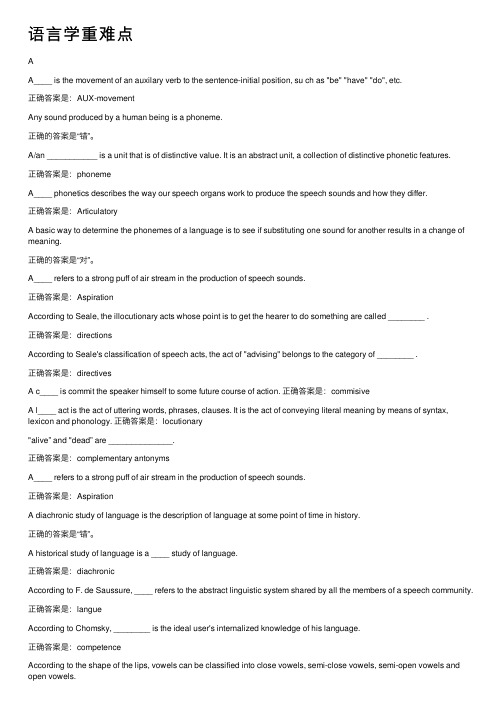
语⾔学重难点AA____ is the movement of an auxilary verb to the sentence-initial position, su ch as "be" "have" "do", etc.正确答案是:AUX-movementAny sound produced by a human being is a phoneme.正确的答案是“错”。
A/an ___________ is a unit that is of distinctive value. It is an abstract unit, a collection of distinctive phonetic features.正确答案是:phonemeA____ phonetics describes the way our speech organs work to produce the speech sounds and how they differ.正确答案是:ArticulatoryA basic way to determine the phonemes of a language is to see if substituting one sound for another results in a change of meaning.正确的答案是“对”。
A____ refers to a strong puff of air stream in the production of speech sounds.正确答案是:AspirationAccording to Seale, the illocutionary acts whose point is to get the hearer to do something are called ________ .正确答案是:directionsAccording to Seale's classification of speech acts, the act of "advising" belongs to the category of ________ .正确答案是:directivesA c____ is commit the speaker himself to some future course of action. 正确答案是:commisiveA l____ act is the act of uttering words, phrases, clauses. It is the act of conveying literal meaning by means of syntax, lexicon and phonology. 正确答案是:locutionary"alive” and "dead” are ______________.正确答案是:complementary antonymsA____ refers to a strong puff of air stream in the production of speech sounds.正确答案是:AspirationA diachronic study of language is the description of language at some point of time in history.正确的答案是“错”。
简明英语语言学教程第二版第6章答案
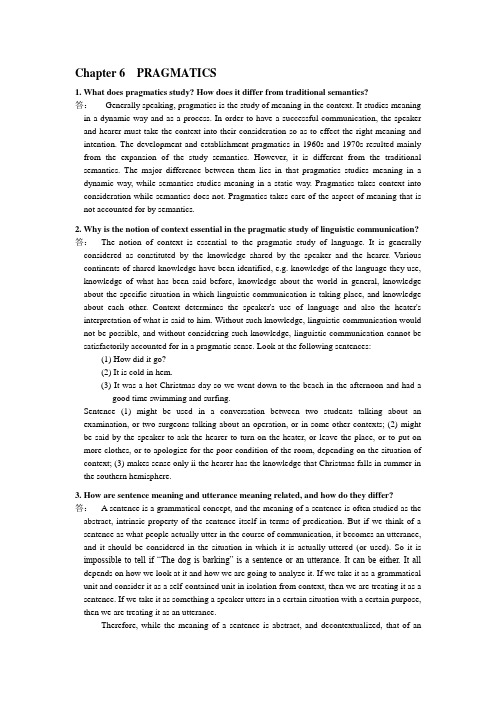
Chapter 6 PRAGMATICS1. What does pragmatics study? How does it differ from traditional semantics?答:Generally speaking, pragmatics is the study of meaning in the context. It studies meaning in a dynamic way and as a process. In order to have a successful communication, the speaker and hearer must take the context into their consideration so as to effect the right meaning and intention. The development and establishment pragmatics in 1960s and 1970s resulted mainly from the expansion of the study semantics. However, it is different from the traditional semantics. The major difference between them lies in that pragmatics studies meaning in a dynamic way, while semantics studies meaning in a static way. Pragmatics takes context into consideration while semantics does not. Pragmatics takes care of the aspect of meaning that is not accounted for by semantics.2. Why is the notion of context essential in the pragmatic study of linguistic communication? 答:The notion of context is essential to the pragmatic study of language. It is generally considered as constituted by the knowledge shared by the speaker and the hearer. Various continents of shared knowledge have been identified, e.g. knowledge of the language they use, knowledge of what has been said before, knowledge about the world in general, knowledge about the specific situation in which linguistic communication is taking place, and knowledge about each other. Context determines the speaker's use of language and also the heater's interpretation of what is said to him. Without such knowledge, linguistic communication would not be possible, and without considering such knowledge, linguistic communication cannot be satisfactorily accounted for in a pragmatic sense. Look at the following sentences:(1) How did it go?(2) It is cold in hem.(3) It was a hot Christmas day so we went down to the beach in the afternoon and had agood time swimming and surfing.Sentence (1) might be used in a conversation between two students talking about an examination, or two surgeons talking about an operation, or in some other contexts; (2) might be said by the speaker to ask the hearer to turn on the heater, or leave the place, or to put on more clothes, or to apologize for the poor condition of the room, depending on the situation of context; (3) makes sense only ii the hearer has the knowledge that Christmas falls in summer in the southern hemisphere.3. How are sentence meaning and utterance meaning related, and how do they differ?答: A sentence is a grammatical concept, and the meaning of a sentence is often studied as the abstract, intrinsic property of the sentence itself in terms of predication. But if we think of a sentence as what people actually utter in the course of communication, it becomes an utterance, and it should be considered in the situation in which it is actually uttered (or used). So it is impossible to tell if “The dog is barking” is a sentence or an utterance. It can be either. It all depends on how we look at it and how we are going to analyze it. If we take it as a grammatical unit and consider it as a self-contained unit in isolation from context, then we are treating it as a sentence. If we take it as something a speaker utters in a certain situation with a certain purpose, then we are treating it as an utterance.Therefore, while the meaning of a sentence is abstract, and decontextualized, that of anutterance is concrete, and context-dependent. The meaning of an utterance is based on sentence meaning; it is the realization of the abstract meaning of a sentence in a real situation of communication, or simply in a context. Now, take the sentence "My bag is heavy" as an example. Semantic analysis of the meaning of the sentence results in the one-place predication BAG (BEING HEA VY). Then a pragmatic analysis of the utterance meaning of the .sentence varies with the context in which it is uttered. For example, it could be uttered by a speaker as a straightforward statement, telling the hearer that his bag is heavy. It could also be intended by the speaker as an indirect, polite request, asking the hearer to help him carry the bag. Another possibility is that the speaker is declining someone's request for help. All these are possible interpretations of the same utterance “M y bag is heavy”. How it is to be underst ood depends on the context in which it is uttered and the purpose for which the speaker utters it.While most utterances take the form of grammatically complete sentences, some utterances do not, and some cannot even be restored to complete sentences.4. Try to think of contexts in which the following sentences can be used for other purposes than just stating facts:a) The room is messy.b) Oh, it is raining!c) The music of the movie is good.d) You have been keeping my notes for a whole week now.答:a) A father entered his son’s room and found it is very messy. Then when he said, “The room is messy,” he was blaming his son for not tidying it up.b) A son asked his father to play with him outside. So when the father said, “Oh, it’s raining”,he meant they couldn’t play outside.c) Two persons just watched a movie and had a discussion of it. One person sai d, “The story ofthe movie is very moving”, so wh en the other person sai d, “The music of the movie is good”, he me ant he didn't think the story of the movie was good.d) A person wanted his notes bac k, so when he said, “you ha ve been keeping my notes for awhole wee k now”, he was demanding the return of his notes.5. According to Austin, what are the three acts a person is possibly performing while making an utterance. Give an example.答:According to Austin's new model, a speaker might be performing three acts simultaneously when speaking: locutionary act, illocutionary act, and perlocutionary act.A locutionary act is the act of uttering words, phrases, clauses. It is the act of conveying literal meaning by means of syntax, lexicon and phonology. An illocutionary act is the act of expressing the speaker’s intention; it is the act performed in saying something. A perlocutionary act is the act performed by or resulting from saying something; it is the consequence of, or the change brought about by the utterance; it is the act performed by saying something. Let's look at an example:You have left the door wide open.The locutionary act performed by the speaker is his utterance of the wo rds “you”, “have”, “door”, “open”, etc. thus expressing what the words literally mean.The illocutionary act performed by the speaker is that by making such an utterance he has expressed his intention of speaking, i.e. asking someone to close the door, or making acomplaint, depending on the context.The perlocutionary act refers to the effect of the utterance. If the hearer gets the speaker's message and sees that the speaker means to tell him to close the door, the speaker has successfully brought about the change in the real world he has intended to; then the perlocutionary act is successfully performed.6. What are the five types of illocutionary speech acts Searle has specified? What is theillocutionary point of each type?答:(1) representatives: stating or describing, saying what the speaker believes to be true(2) directives: trying to get the hearer to do something(3) commissives: committing the speaker himself to some future course of action(4) expressives: expressing feelings or attitude towards an existing(5) declarations: bringing about immediate changes by saying somethingThe illocutionary point of the representatives is to commit the speaker to something's being the case, to the truth of what has been said, in other words, when performing an illocutionary act of representative, the speaker is making a statement or giving a description which he himself believes to be true. Stating, believing, sweating, hypothesizing are among the most typical of the representatives.Directives ate attempts by the speaker to get the hearer to do some- thing. Inviting, suggesting, requesting, advising, wanting, threatening and ordering are all specific instances of this class.Commissives are those illocutionary acts whose point is to commit the speaker to some future course of action, i.e. when speaking the speaker puts himself under a certain obligation. Promising, undertaking, vowing are the most typical ones.The illocutionary point of expressives is to express the psychological state specified in the utterance. The speaker is expressing his feelings or attitudes towards an existing state of affairs, e.g. apologizing, thanking, congratulating.The last class “declarations” has the characteristic that the successful performance of an act of this type brings about the correspondence between what is said and reality.7. What is indirect language use? How is it explained in the light of speech act theory?答:When someone is not saying I an explicit and straightforward manner what he means to say, rather he is trying to put across his message in an implicit, roundabout way, we can say he is using indirect language.Explanation (略) (见教材p.84-85)8. What are the four maxims of the CP? Try to give your own examples to show how floutingthese maxims gives rise to conversational implicature?答:Cooperative Principle, abbreviated as CP. It goes as follows:Make your conversational contribution such as required at the stage at which it occurs by the accepted purpose or direction of the talk exchange in which you are engaged.To be more specific, there are four maxims under this general principle:(1) The maxim of quantity①Make your contribution as informative as required (for the current purpose of theexchange).②Do not make your contribution more informative than is required.(2) The maxim of quality①Do not say what you believe to be false.②Do not say that for which you lack adequate evidence.(3) The maxim of relationBe relevant.(4) The maxim of manner①Avoid obscurity of expression.②Avoid ambiguity.③Be brief (avoid unnecessary prolixity).④Be orderly.9. What is pragmatic failure? Try to find instances of pragmatic failure in the English usedby Chinese learners of English.答:The technical term for breakdowns in the course of communication is pragmatic failure.Pragmatic failure occurs when the speaker fails to use language effectively to achieve a specific communication purpose, or when the hearer fails to recognize the intention or the illocutionary force of the speaker’s utterance in the context of communication.Instances (略) (见教材p.89)。
score考研英语阅读
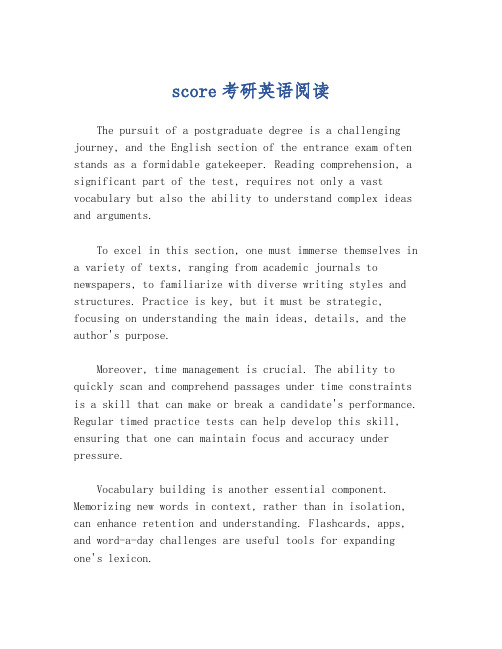
score考研英语阅读The pursuit of a postgraduate degree is a challenging journey, and the English section of the entrance exam often stands as a formidable gatekeeper. Reading comprehension, a significant part of the test, requires not only a vast vocabulary but also the ability to understand complex ideas and arguments.To excel in this section, one must immerse themselves in a variety of texts, ranging from academic journals to newspapers, to familiarize with diverse writing styles and structures. Practice is key, but it must be strategic, focusing on understanding the main ideas, details, and the author's purpose.Moreover, time management is crucial. The ability to quickly scan and comprehend passages under time constraints is a skill that can make or break a candidate's performance. Regular timed practice tests can help develop this skill, ensuring that one can maintain focus and accuracy under pressure.Vocabulary building is another essential component. Memorizing new words in context, rather than in isolation, can enhance retention and understanding. Flashcards, apps, and word-a-day challenges are useful tools for expandingone's lexicon.Additionally, understanding the nuances of grammar and sentence structure is vital. This knowledge aids indeciphering complex sentences and can provide clues to the author's intent, which is often tested in comprehension questions.Lastly, developing critical thinking skills is indispensable. The ability to analyze, infer, and evaluatethe information presented in the text is what sets apart the top scorers. Engaging in discussions, writing summaries, and questioning the text can sharpen these skills.In summary, mastering the art of reading comprehensionfor the postgraduate entrance exam is a multifaceted endeavor. It involves a combination of strategic practice, vocabulary expansion, time management, grammatical understanding, and critical thinking. With dedication and the right approach, conquering this section is well within reach.。
外研社版七年级英语上册 - 一年级起点单词列表、例句汇总
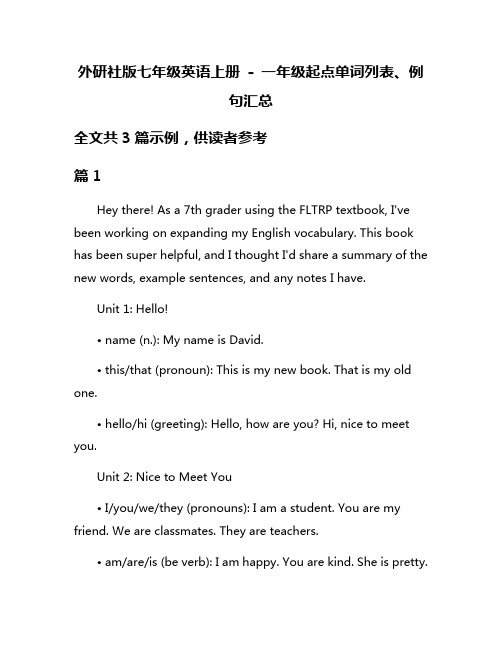
外研社版七年级英语上册- 一年级起点单词列表、例句汇总全文共3篇示例,供读者参考篇1Hey there! As a 7th grader using the FLTRP textbook, I've been working on expanding my English vocabulary. This book has been super helpful, and I thought I'd share a summary of the new words, example sentences, and any notes I have.Unit 1: Hello!• name (n.): My name is David.• this/that (pronoun): This is my new book. That is my old one.• hello/hi (greeting): Hello, how are you? Hi, nice to meet you.Unit 2: Nice to Meet You• I/you/we/they (pronouns): I am a student. You ar e my friend. We are classmates. They are teachers.• am/are/is (be verb): I am happy. You are kind. She is pretty.• what/who (question words): What is your name? Who is that girl?Unit 3: This is My Family• father/mother/parents (n.): My father works hard. My mother cooks well. My parents love me.• brother/sister (n.): I have one younger brother. She has two older sisters.• his/her/their (possessive adjectives): This is his book. That is her pen. Those are their toys.Unit 4: Colors• red/blue/green/yellow... (colors): I like red apples. The sky is blue. Grass is green. The sun is yellow.• what color (question): What color is your shirt? It's white and black.Unit 5: Animals• dog/cat/bird/fish... (animals): D ogs are man's best friends. Cats are cute. Birds can fly. Fish live in water.• have/has (helping verbs): I have a pet dog. He has two cats. They have many birds.Unit 6: My Classroom• desk/chair/blackboard... (classroom objects): Sit at your desk. This chair is broken. Write on the blackboard.• teacher/student (n.): The teacher is very kind. The students are hardworking.That covers the key vocabulary from the first half of the book. The example sentences really helped me understand how to use the words properly. I'll keep working on mastering these, while getting ready for all the new words coming up next semester!篇2Title: Mastering the FLTRP 7th Grade English Vocabulary – A Year One Student's JourneyAs a Year One student tackling the 7th grade English textbook from FLTRP, I found myself faced with a daunting task –mastering the extensive vocabulary list. Little did I know that this challenge would not only expand my English lexicon but also open up a world of understanding and self-discovery.The vocabulary list, meticulously curated by the FLTRP experts, was a treasure trove of words that seemed to come alive on the pages. Each word carried its own unique story, waiting tobe unraveled and embraced. From the simplest of nouns like "apple" and "book" to the more complex adjectives like "diligent" and "extraordinary," every word held the potential to paint vivid pictures in my mind.As I delved deeper into the list, I encountered words that resonated with my personal experiences. "Family," for instance, took on a whole new meaning as I reflected on the bonds that tied me to my loved ones. The example sentence, "My family is the most important thing in my life," struck a chord within me, reminding me of the unwavering support and love that surrounded me.Other words, like "friendship," opened up a world of possibilities. The sentence "A true friend is someone who understands and accepts you for who you are" resonated deeply, inspiring me to cherish the relationships that brought joy and comfort into my life.As I progressed through the chapters, I found myself drawn to words that challenged my perspective. "Perseverance" and "resilience" became mantras that motivated me to push through obstacles and embrace challenges head-on. The example sentences, such as "With perseverance, even the most daunting tasks can be accomplished," and "Resilience is the ability tobounce back from setbacks," instilled in me a sense of determination and grit.Certain words, like "empathy" and "compassion," sparked profound realizations about the world around me. The sentences "Empathy allows us to understand and share the feelings of others" and "Compassion is the humane quality of understanding and caring for others" opened my eyes to the importance of cultivating a sense of understanding and kindness towards those around me.The vocabulary list was not merely a collection of words; it was a gateway to self-discovery and personal growth. Each word carried a story, a lesson, and a glimpse into the richness of the English language. As I mastered the list, I found myself not only expanding my linguistic abilities but also gaining a deeper appreciation for the nuances of human experience.One word that particularly resonated with me was "curiosity." The example sentence, "Curiosity is the key to learning and discovering new things," struck a chord within me. It reminded me that the journey of learning is never-ending, and that embracing a spirit of curiosity would unlock doors to knowledge and understanding that I had yet to explore.As I neared the end of the vocabulary list, I couldn't help but reflect on the transformative journey I had undertaken. What had initially seemed like a daunting task had become a source of inspiration and personal growth. The words had become more than just entries in a textbook; they had become tools forself-expression, empathy, and understanding.Looking back, I realized that mastering the FLTRP 7th grade English vocabulary was not just about memorizing definitions and examples. It was about embracing the power of language to shape our thoughts, emotions, and perspectives. Each word carried the potential to unlock new realms of understanding, fostering connections with others and deepening our appreciation for the world around us.As I move forward in my English studies, I carry with me the lessons learned from this vocabulary journey. The words have become companions, guiding me through the complexities of篇3Mastering Vocabulary: My Journey with the FLTRP Grade 7 English BookAs a 7th grader diving into the world of English, the FLTRP textbook has been my constant companion. At first, the sheervolume of new vocabulary felt daunting, but gradually, I've learned to embrace the challenge and make these words my own. Let me share my journey with you, fellow learners!Unit 1: A Fresh StartFrom the get-go, we were introduced to words like "subject," "classmate," and "introduce." Simple yet essential, these words laid the foundation for our English adventure. "Hi, my name is [your name]. Nice to meet you!" became our mantra for breaking the ice.Unit 2: My DayThis unit brought us closer to our daily routines with words like "wake up," "have breakfast," and "go to school." Suddenly, describing our mornings in English felt natural: "I wake up at 7 a.m. and have cereal for breakfast before going to school."Unit 3: My FamilyFamily ties were strengthened with words like "father," "mother," "brother," and "sister." We learned to introduce our loved ones: "This is my younger sister, Amy. She's ten years old."Unit 4: My FavoritesExpressing our preferences became a breeze with words like "favorite," "like," and "love." We could proudly declare, "My favorite subject is English, and I love reading books!"Unit 5: My BirthdayCelebrating milestones took on a new flair with words like "birthday," "cake," and "present." We could excitedly say, "I got a new bike for my birthday present!"Unit 6: My BodyUnderstanding our anatomy was made easier with words like "head," "arm," "leg," and "foot." We could even point and say, "This is my arm, and those are my feet."Unit 7: My PetDescribing our furry (or scaly) friends became possible with words like "dog," "cat," "fish," and "rabbit." We could proudly introduce, "This is my pet dog, Buddy. He's very friendly!"Unit 8: My ClothesDressing up got a linguistic twist with words like "shirt," "pants," "dress," and "shoes." We could confidently describe our outfits: "I'm wearing a blue shirt and black pants today."Unit 9: My RoomOur personal spaces came alive with words like "bed," "desk," "chair," and "bookcase." We could give virtual tours: "This is my room. That's my bed, and over there is my desk where I study."Unit 10: My HobbiesExpressing our interests became a breeze with words like "play," "read," "sing," and "dance." We could proudly share, "My hobby is dancing. I love to sing and dance!"Unit 11: My WeekendWeekends got a linguistic makeover with words like "Saturday," "Sunday," "go," and "watch." We could recount our adventures: "On Saturday, I went to the park and watched birds with my friends."Unit 12: My SchoolOur educational environment came to life with words like "teacher," "classroom," "playground," and "library." We could proudly give a tour: "This is our classroom, and that's the playground where we play during recess."As I reflect on this journey, I'm amazed at how far I've come. From simple greetings to intricate descriptions, these vocabulary words have become my linguistic toolkit, enabling me to expressmyself confidently in English. The FLTRP textbook has been a faithful companion, guiding me through the nuances of the language and helping me forge connections with people and the world around me.To my fellow learners, embrace the challenge of new vocabulary with open arms. Immerse yourself in the words, practice them diligently, and watch as they become ingrained in your linguistic repertoire. The journey may seem daunting at first, but with perseverance and dedication, you'll soon find yourself fluently navigating the rich tapestry of the English language.。
我要一直读这篇作文英语
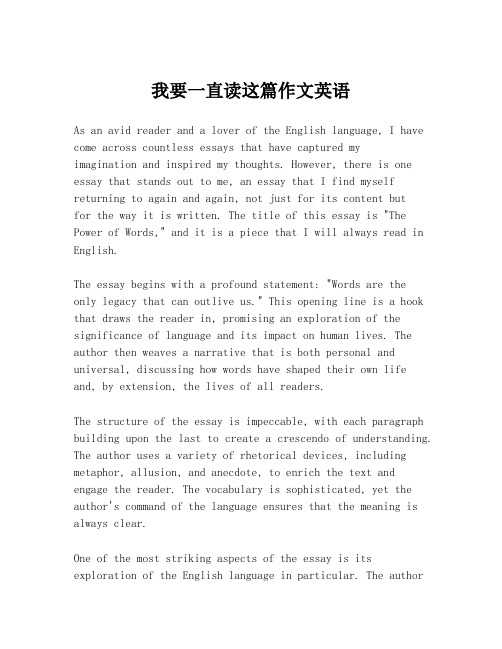
我要一直读这篇作文英语As an avid reader and a lover of the English language, I have come across countless essays that have captured myimagination and inspired my thoughts. However, there is one essay that stands out to me, an essay that I find myself returning to again and again, not just for its content butfor the way it is written. The title of this essay is "The Power of Words," and it is a piece that I will always read in English.The essay begins with a profound statement: "Words are theonly legacy that can outlive us." This opening line is a hook that draws the reader in, promising an exploration of the significance of language and its impact on human lives. The author then weaves a narrative that is both personal and universal, discussing how words have shaped their own life and, by extension, the lives of all readers.The structure of the essay is impeccable, with each paragraph building upon the last to create a crescendo of understanding. The author uses a variety of rhetorical devices, including metaphor, allusion, and anecdote, to enrich the text and engage the reader. The vocabulary is sophisticated, yet the author's command of the language ensures that the meaning is always clear.One of the most striking aspects of the essay is its exploration of the English language in particular. The authorargues that English, with its vast lexicon and flexible grammar, offers a unique platform for expressing complexideas and emotions. They discuss the evolution of the language, from its roots in Germanic and Latin to its current status as a global lingua franca, and how this evolution has shaped the way we communicate today.The essay also delves into the power of reading and writingin English. It speaks to the transformative effect that literature can have on individuals and societies,highlighting the works of various authors who have used the English language to challenge norms, inspire change, and provide comfort. The author's passion for the subject is evident in every sentence, and it is this passion that makes the essay so compelling.Moreover, the essay is not just a celebration of the English language; it is also a call to action. The author encourages readers to explore the vast repository of English literature, to learn from the masters of the craft, and to use the language as a tool for personal growth and social progress. They argue that by reading and writing in English, we can not only improve our communication skills but also broaden our horizons and deepen our understanding of the world.In conclusion, "The Power of Words" is an essay thatresonates with me on a deep level. It is a testament to the beauty and potential of the English language, and it servesas a reminder of why I will always read this essay in English. The essay is a masterpiece of prose, a tribute to the powerof words, and an inspiration to all who seek to harness thatpower for good. It is a piece that I will continue to read, to learn from, and to share with others, ensuring that its message and its magic are passed on to future generations of English language enthusiasts.。
传统的的英语作文
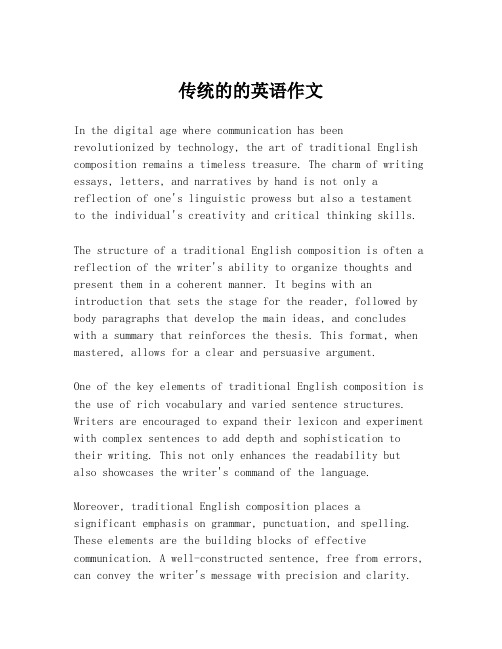
传统的的英语作文In the digital age where communication has beenrevolutionized by technology, the art of traditional English composition remains a timeless treasure. The charm of writing essays, letters, and narratives by hand is not only a reflection of one's linguistic prowess but also a testament to the individual's creativity and critical thinking skills.The structure of a traditional English composition is often a reflection of the writer's ability to organize thoughts and present them in a coherent manner. It begins with an introduction that sets the stage for the reader, followed by body paragraphs that develop the main ideas, and concludes with a summary that reinforces the thesis. This format, when mastered, allows for a clear and persuasive argument.One of the key elements of traditional English composition is the use of rich vocabulary and varied sentence structures. Writers are encouraged to expand their lexicon and experiment with complex sentences to add depth and sophistication to their writing. This not only enhances the readability but also showcases the writer's command of the language.Moreover, traditional English composition places asignificant emphasis on grammar, punctuation, and spelling. These elements are the building blocks of effective communication. A well-constructed sentence, free from errors, can convey the writer's message with precision and clarity.Furthermore, the process of drafting, revising, and editing a traditional English composition is an exercise in patience and diligence. It teaches writers to be meticulous and to value the power of revision. The act of refining one's work until it is polished and eloquent is a skill that extends beyond the realm of writing.In conclusion, the charm of traditional English composition lies in its ability to foster a deep appreciation for the English language and its nuances. It is a craft that requires dedication, practice, and a keen eye for detail. As we continue to embrace new forms of communication, it is important to preserve the elegance and effectiveness of traditional English composition.。
迈入的英语作文怎么写
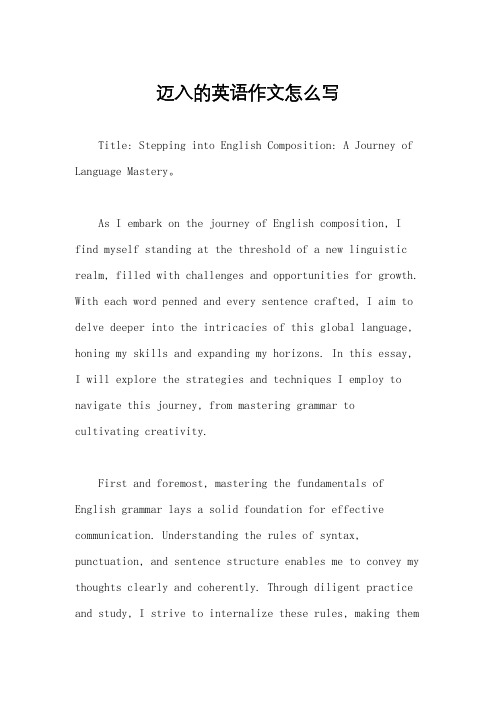
迈入的英语作文怎么写Title: Stepping into English Composition: A Journey of Language Mastery。
As I embark on the journey of English composition, I find myself standing at the threshold of a new linguistic realm, filled with challenges and opportunities for growth. With each word penned and every sentence crafted, I aim to delve deeper into the intricacies of this global language, honing my skills and expanding my horizons. In this essay, I will explore the strategies and techniques I employ to navigate this journey, from mastering grammar tocultivating creativity.First and foremost, mastering the fundamentals of English grammar lays a solid foundation for effective communication. Understanding the rules of syntax, punctuation, and sentence structure enables me to convey my thoughts clearly and coherently. Through diligent practice and study, I strive to internalize these rules, making themsecond nature in my writing process. Additionally, Iutilize various resources such as grammar books, online courses, and language learning apps to reinforce my knowledge and address any areas of weakness.In addition to grammar, vocabulary acquisition plays a crucial role in enriching my writing. I make a conscious effort to expand my lexicon by regularly reading English literature, newspapers, and academic articles. Whenever I encounter unfamiliar words, I take note of them and incorporate them into my vocabulary through mnemonicdevices and contextual understanding. Moreover, I utilize vocabulary-building tools such as flashcards and word games to reinforce retention and deepen my word bank.Beyond the technical aspects of language, creativityand expression are essential components of compelling writing. To foster creativity, I engage in activities such as free writing, brainstorming, and mind mapping togenerate ideas and explore different perspectives. Moreover, I draw inspiration from diverse sources such as art, music, and nature, allowing my imagination to soar beyond theconfines of conventional thinking. By embracing experimentation and embracing my unique voice, I strive to infuse my writing with originality and depth.Furthermore, the process of English composition extends beyond mere linguistic proficiency to encompass critical thinking and analytical skills. As I analyze and evaluate various texts and arguments, I develop a deeper understanding of rhetorical strategies, logical reasoning, and persuasive techniques. By deconstructing and synthesizing complex ideas, I sharpen my ability to communicate persuasively and persuasively articulate my thoughts and opinions.In conclusion, stepping into English composition is not merely a journey of linguistic acquisition but a transformative experience that shapes my intellect and worldview. Through dedication, perseverance, and a thirst for knowledge, I aspire to transcend linguistic barriers and emerge as a proficient and articulate communicator. As I continue to refine my writing skills, I am excited to explore new genres, experiment with different styles, andultimately, make my mark in the vast landscape of English literature and discourse.。
情感分析模型英语
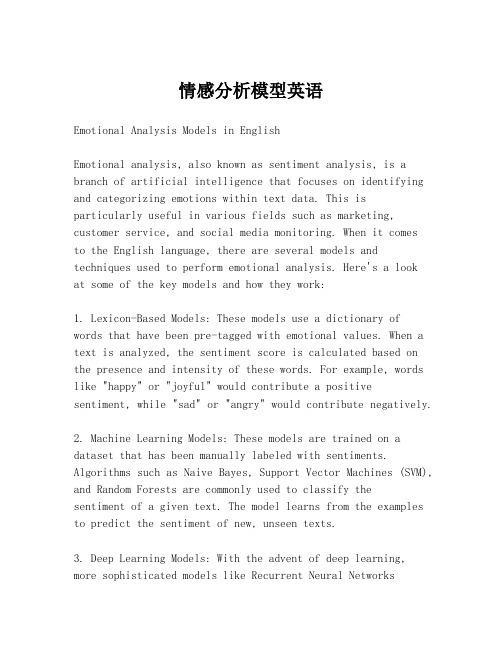
情感分析模型英语Emotional Analysis Models in EnglishEmotional analysis, also known as sentiment analysis, is a branch of artificial intelligence that focuses on identifying and categorizing emotions within text data. This isparticularly useful in various fields such as marketing, customer service, and social media monitoring. When it comesto the English language, there are several models and techniques used to perform emotional analysis. Here's a lookat some of the key models and how they work:1. Lexicon-Based Models: These models use a dictionary of words that have been pre-tagged with emotional values. When a text is analyzed, the sentiment score is calculated based on the presence and intensity of these words. For example, words like "happy" or "joyful" would contribute a positive sentiment, while "sad" or "angry" would contribute negatively.2. Machine Learning Models: These models are trained on a dataset that has been manually labeled with sentiments. Algorithms such as Naive Bayes, Support Vector Machines (SVM), and Random Forests are commonly used to classify thesentiment of a given text. The model learns from the examples to predict the sentiment of new, unseen texts.3. Deep Learning Models: With the advent of deep learning, more sophisticated models like Recurrent Neural Networks(RNNs) and Long Short-Term Memory (LSTM) networks have been applied to emotional analysis. These models can capture the context and sequence of words in a sentence, which is crucial for understanding the nuanced emotions in English text.4. Hybrid Models: Some models combine the strengths of lexicon-based and machine learning approaches. They use a lexicon to boost the performance of a machine learning model or to interpret the results of a deep learning model.5. Contextual Models: These models take into account the context in which words are used. For example, sarcasm or irony can completely change the sentiment of a sentence, and these models attempt to understand the context to provide a more accurate analysis.6. Multimodal Models: In some cases, emotional analysis is not limited to text alone. Multimodal models also consider other forms of data, such as images or audio, to provide a more comprehensive sentiment analysis.When applying emotional analysis models to English text, it's important to consider the complexity of the language, including idioms, slang, and cultural references, which can all affect the sentiment conveyed. Additionally, the choice of model often depends on the specific requirements of the task at hand, such as the need for real-time analysis or the importance of accuracy versus computational efficiency.。
感谢女儿英语作文

感谢女儿英语作文Dear [Daughter's Name],I am writing to express my heartfelt gratitude for the English essay you composed. Your dedication to improving your language skills and the effort you put into crafting such a thoughtful piece is truly commendable.Firstly, I must say that your choice of topic was both engaging and relevant. It not only showcased your ability to think critically but also your capacity to connect with the reader on a personal level. Your essay was a delightful blend of narrative and persuasive writing, which is no small feat for a student of your age.The structure of your essay was well-organized, with a clear introduction, body, and conclusion. Your introduction effectively set the stage for the discussion that followed, and your conclusion was a powerful summary that reinforced the key points you presented.Your vocabulary was impressive, and it was evident that you have been working hard to expand your lexicon. The use of idiomatic expressions and complex sentence structures added a level of sophistication to your writing, which is a testament to your growing proficiency in English.Moreover, your grammar and punctuation were mostly accurate,which is crucial for clear communication. The few minor errors you made can be easily corrected with a bit more practice, and I am confident that you will continue to improve in this area.Lastly, I would like to commend you for your creativity and originality. Your personal anecdotes and unique perspectives brought a fresh and authentic voice to your essay, which is something that truly sets your writing apart.Keep up the excellent work, and never stop striving for excellence. Your progress and achievements are a source of immense pride and joy for me. I am looking forward to reading more of your compositions in the future.With love and admiration,[Your Name]。
介绍于敏英语作文
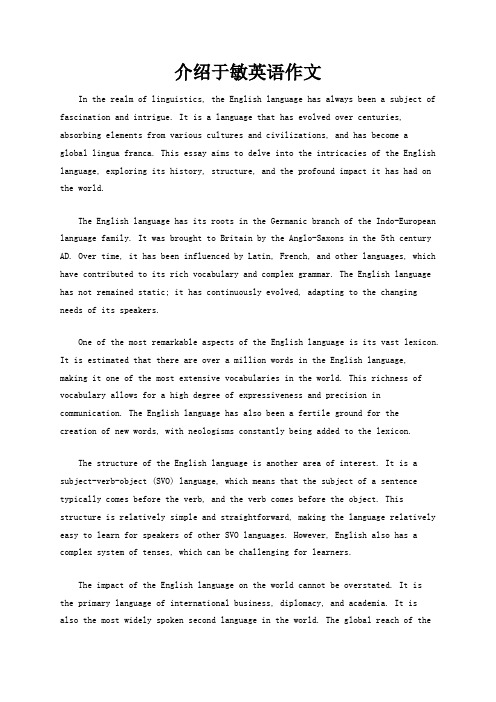
介绍于敏英语作文In the realm of linguistics, the English language has always been a subject of fascination and intrigue. It is a language that has evolved over centuries, absorbing elements from various cultures and civilizations, and has become aglobal lingua franca. This essay aims to delve into the intricacies of the English language, exploring its history, structure, and the profound impact it has had on the world.The English language has its roots in the Germanic branch of the Indo-European language family. It was brought to Britain by the Anglo-Saxons in the 5th century AD. Over time, it has been influenced by Latin, French, and other languages, which have contributed to its rich vocabulary and complex grammar. The English language has not remained static; it has continuously evolved, adapting to the changing needs of its speakers.One of the most remarkable aspects of the English language is its vast lexicon. It is estimated that there are over a million words in the English language, making it one of the most extensive vocabularies in the world. This richness of vocabulary allows for a high degree of expressiveness and precision in communication. The English language has also been a fertile ground for thecreation of new words, with neologisms constantly being added to the lexicon.The structure of the English language is another area of interest. It is a subject-verb-object (SVO) language, which means that the subject of a sentence typically comes before the verb, and the verb comes before the object. This structure is relatively simple and straightforward, making the language relatively easy to learn for speakers of other SVO languages. However, English also has a complex system of tenses, which can be challenging for learners.The impact of the English language on the world cannot be overstated. It isthe primary language of international business, diplomacy, and academia. It isalso the most widely spoken second language in the world. The global reach of theEnglish language has facilitated cross-cultural communication and has played a significant role in the dissemination of knowledge and ideas.However, the dominance of the English language has also been a source of concern for some. There is a fear that the spread of English could lead to the erosion of other languages and cultures. It is essential to strike a balance between promoting the use of English for global communication and preserving linguistic diversity.In conclusion, the English language is a fascinating and complex subject that has had a profound impact on the world. Its rich vocabulary, straightforward structure, and global reach have made it an essential tool for communication in the modern world. However, it is crucial to be mindful of the potential negative consequences of its dominance and strive to maintain linguistic diversity.This essay has been written with a deep appreciation for the English language and its many facets. It is a testament to the power of language to connect people from different cultures and backgrounds. As we continue to navigate the complexities of the modern world, the English language will undoubtedly continue to play a vital role in facilitating communication and understanding.。
- 1、下载文档前请自行甄别文档内容的完整性,平台不提供额外的编辑、内容补充、找答案等附加服务。
- 2、"仅部分预览"的文档,不可在线预览部分如存在完整性等问题,可反馈申请退款(可完整预览的文档不适用该条件!)。
- 3、如文档侵犯您的权益,请联系客服反馈,我们会尽快为您处理(人工客服工作时间:9:00-18:30)。
A summary of the lexicon and sentence structureAt the beginning, several concepts of sentence structure are introduced. Phrases, which are organized hierarchically by words, are the immediate constituents of a sentence. We can test whether a phrase structure is a constituent of a sentence or not by operations such as preposing and question formation. On the one hand, only constituents of the sentence such as NP and VP can be preposed. On the other hand, in constituent questions, the SAI process applies and a sentence-initial question word substitute for the constituent which is being questioned. These two operations in turn provide evidence for the role of phrase structure in syntax.2Words, which are the ultimate constituents of a sentence, can be divided into different syntactic categories. Any language will have this kind of categorical information since the formation of sentences is partly determined by it. The native speakers of a language have internalized lexicon to decide which category a certain word belongs to. But this kind of word knowledge is learnt by each native under the guidance of UG rather than innate.Different categories of words have their own distributions in sentence structure. For one thing, terminal category labels restrict which lexical elements can be inserted. For the other, the phrasal category is determined by the head of the phrase, which is originally determined by the lexical category of the inserted word. However, only match lexical categories with the phrases’would not necessarily make a good sentence. In other words, grammaticality can not prove a sentence to be acceptable, only our logic and beliefs can.3Subcategorization frames identifies the subcategories of verbs. First, the PP provides information about manner, time and place, which is optional. These optional constituents are called adjuncts. Second, there should be one or more NPs in the VP, or there should be no NPs in the VP. According to the requirements above, verbs canbe classified by the own properties of themselves to three categories: ditransitive, transitive and intransitive verbs. And this knowledge of verb classification is a part of the native speaker’s internal lexical knowledge. So the information of a verb in a VP can directly lead to the encoding of the complement structure.In the Chomskian tradition the notions are encoded in distributional frames. In general, the transitive verb requires an NP complement while the intransitive verb requires none complement. And the ditransitive verb requires two NPs or an NP and a PP. This frame identifies the subcategories of the verbs.3.2The classification of verbs is not a primitive property of the grammar, but is followed by the actions or states they expressed and by their meaning. The commonly adopted logician notion “participants in an activity”is applied to linguistics as the notion of argument structure and thematic structure. The NPs which represent a person or an entity from the universe of discourse are referred to as arguments. And the predicates define the relation between the arguments. Two-place predicates are predicates that require two arguments, which approximately correspond to the transitive verbs. Similarly, one-place predicate correspond to the intransitive verbs, which take only one argument.Furthermore, the argument structure can be similar to a play. The arguments are the minimal constituents involved in the activity of state expressed by the predicate. They can be described as the roles in a play, which is determined by the script of the play, that is to say, the predicate. And for each role one and only one actor must be assigned. The argument structure, which governed by the meaning of the verbs, can partly replace the classification of verbs in terms of transitivity labels or subcategorization frames. The meaning of a verb express the activity and state encoded in it, and thus the speaker knows the participants involved. In this way, the number of arguments is expected. But only the number rather than the types of the arguments can be predicted because arguments might have been realized by categories other than NP.Not only verbs, other lexical categories also have argument structure.And again in the play metaphor, the script of a play not only defines the number of the actors involved, but also specifies which roles the actors have to play. The relations between the verbs and their arguments are referred to as thematic roles. The thematic structure is by now quite sketchy. For instance, the roles and their labels in thematic structure are in disagreement.The thematic grid helps to specify not only the number of arguments of a predicate, but also the types of semantic roles of those arguments. In the theta grid, each thematic role with its predicates must be assigned to arguments. Conversely, the referring NPs in the grid must bear some semantic relation to a predicate. Each thematic role must be assigned to an argument and there must be no NPs which lack a thematic role. Thus the theta criterion is summed: (1) Each argument is assigned one and only one theta role. (2)Each theta role is assigned one and only one argument. We are quite clear by nature how many arguments a predicate require in a given discourse. So we can easily list the number of arguments, regardless of the theta role of each predicate.4Whether it is the lexical items which play an important role in syntactic representation or it is the subcategorization of the verbs that determine the category of the phrase, or the thematic structure of a predicate, the idea that lexical information to a large extent determines syntactic structure is summed up in the projection principle: lexical information is syntactically represented.5It is proved by evidence that not all the arguments are realized by NPs. In addition to NP-arguments, there are clausal arguments which are formed by sentences. As it is shown in the case, both NPs and sentences can be assigned to theta roles. But there is some difference between the two kinds of arguments in that object clauses do not occupy the same position as the object NP. Non-finite clause is represented with words without a fixed form. Another kind of sentence argument is “verbless clause”which serves to indicate a constituent with a propositional meaning. For example, a “verbless clause” might have the meaning of a complete clausal structure, but it lacks any verb forms. Non-finite and verbless clauses are subordinated to other main predicates so they are not normally found as independent clauses.On the contrary, some NPs in the arguments positions are not assigned to thematic roles, hence not the arguments of the predicate. From the observations of the functions of “it” in different sentences, we conclude that “it” plays no role in thematic roles and has no semantic meaning and that its presence in the sentence is simply for some structural reason. One explanation of this phenomenon is that English sentences must have an overt subject. The dummy pronoun is called expletive pronoun. As for the word “there”, it is not an adjunct of place which can be questioned. Neither can it be omitted freely. Also it contributes nothing to the meaning of the sentences, let alone playing a theta role. Again the data shows that it exist for structural reasons, just as the word “it”. Unlike “it”, “there” is associated with NP-subjects and it can not be associated with clausal subjects. Expletives such as “it” and “there” lack a theta role and they can not be assigned to arguments.We all know that verbs can be divided into lexical verbs and auxiliaries. The negation element n’t follows the auxiliaries when they need to express the negative effect. In a yes-no question the auxiliaries and the subject of the sentence are inverted while the lexical verbs do not. It is the same that auxiliaries do not assign thematic roles.The projection principle and the EPP work together to form grammatical sentence structure. The EPP suggest that a sentence must have a subject.The canonical realization proposes that categorical selection follows from semantic selection. And we can not eliminate categorical selection from lexical information.。
